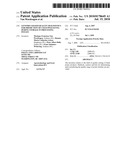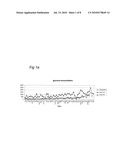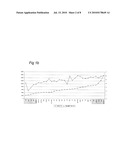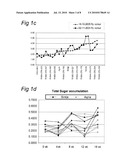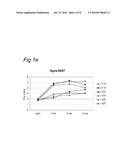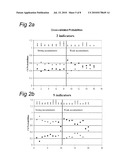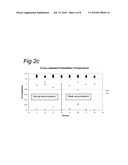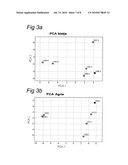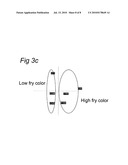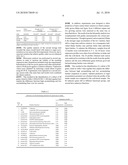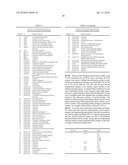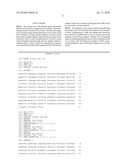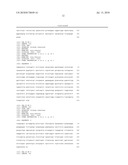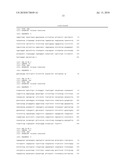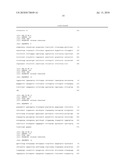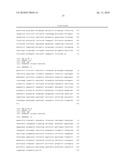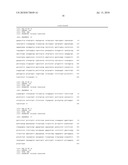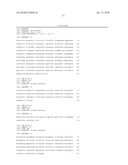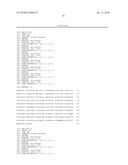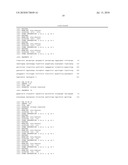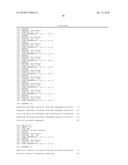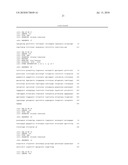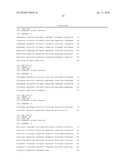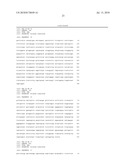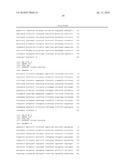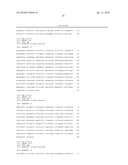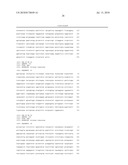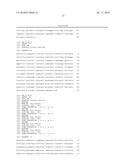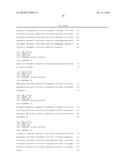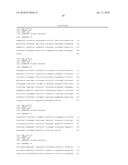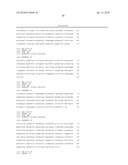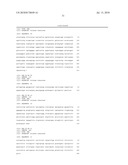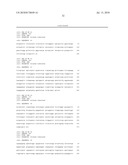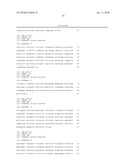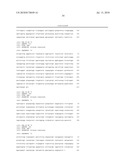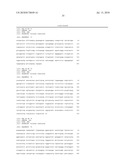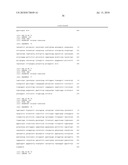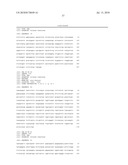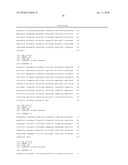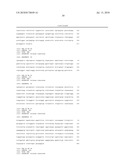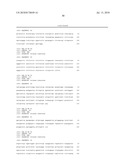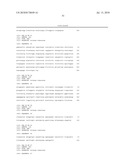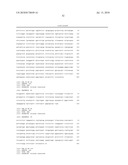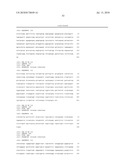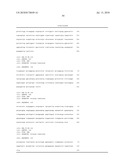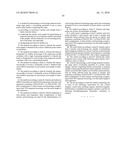Patent application title: GENOMICS-BASED QUALITY DIAGNOSTICS FOR PREDICTION OF COLD-SWEETENNG DURING STORAGE IN PROCESSING POTATO
Inventors:
Monique Francisca Van Wordragen (Arnhem, NL)
Renata Maria Catharina Ariens (Bergharen, NL)
Peter Albert Balk (Zetten, NL)
Peter Albert Balk (Zetten, NL)
Ernst Johannes Woltering (Arnhem, NL)
IPC8 Class: AC12Q168FI
USPC Class:
435 6
Class name: Chemistry: molecular biology and microbiology measuring or testing process involving enzymes or micro-organisms; composition or test strip therefore; processes of forming such composition or test strip involving nucleic acid
Publication date: 2010-07-15
Patent application number: 20100178649
Claims:
1. A method for determining a cold-storage induced sweetening stage and/or
a sweetening potential of one or more potato tuber batches comprising the
steps:(a) providing or receiving a nucleic acid sample from a batch of
potato tubers,(b) analyzing the nucleic acid sample by determining an
expression profile of a set of indicator mRNA transcripts in the sample,
which is indicative of a sweetening potential of the batch, and
optionally(c) designating the batch for further use.
2. The method according to claim 1, wherein the nucleic acid sample is obtained from at least 5 different potato tubers of said batch.
3. The method according to claim 1, wherein the batch is designated for further processing if the expression profile correlates with a high sweetening potential or wherein the batch is designated for cold storage if the expression profile correlates with a low sweetening potential.
4. The method according to claim 1, whereby the expression profile of at least 2, preferably at least 3, different indicator mRNA transcripts in said nucleic acid sample is determined.
5. The method according to claim 4, whereby the expression profile of at least 5, preferably at least 10 different indicator mRNA transcripts in said nucleic acid sample is determined.
6. The method according to claim 5, wherein said indicator mRNA transcripts are selected from the group of nucleic acid sequences consisting of SEQ ID NO: 1 to SEQ ID NO: 106, their complements, or their nucleic acid homologs comprising at least 70% sequence homology over the entire length of said sequences.
7. The method according to claim 6, wherein fragments of said nucleic acid sequences, their complements, or their nucleic acid homologs are used for the determination of a cold-storage induced sweetening stage and/or the sweetening potential of one or more batches of potato tubers or portions thereof.
8. The method according to claim 7, wherein said fragments are at least 10 nucleotides in length.
9. A solid carrier comprising at least 3 nucleic acid molecules attached to said carrier, said at least 3 nucleic acid molecules being selected from the group of nucleic acid sequences consisting of SEQ ID NO: 1 to SEQ ID NO: 106, their complements, or their nucleic acid homologs comprising at least 70% sequence homology over the entire length of said sequences.
10. The solid carrier according to claim 9, wherein said at least 3 nucleic acid homologs are capable of hybridizing under stringent conditions to at least 3 nucleic acid molecules selected from the group of nucleic acid sequences consisting of SEQ ID NO: 1 to SEQ ID NO: 106 or their complements.
11. The carrier according to claim 9, wherein the carrier comprises one or more of the following: glass, plastic, nitrocellulose, nylon or silicon.
12. A kit for determining a cold-storage induced sweetening stage and/or sweetening potential of a potato tissue sample, said kit comprising nucleic acid probes or primers capable of detecting the presence and/or quantity of at least 3 nucleic acid molecules within a set of nucleic acid molecules, said set being selected from the group of nucleic acid sequences consisting of SEQ ID NO: 1 to SEQ ID NO: 106, their complements, or their nucleic acid homologs comprising at least 70% sequence homology over the entire length of said sequences.
13. The kit according to claim 12, further comprising one or more of the following: instructions for use, control samples, control data, labeling reagents, detection reagents, hybridization or amplification reagents, primers or probes for detecting housekeeping-gene transcripts, containers or carriers.
Description:
FIELD OF THE INVENTION
[0001]The present invention relates to the field of quality testing of fresh plant-based potato products. Provided are methods for quality testing and quality prediction and diagnostic kits for quality screening and selection/discrimination of high, medium or low quality products or batches having approximately the same quality level. In particular, relative or absolute mRNA expression levels of defined sets of gene transcripts are determined, whereby a specific stage of a quality trait is determined. The cold-storage induced sweetening potential of batches of potato tubers can, thereby, be predicted.
BACKGROUND OF THE INVENTION
[0002]One of the main factors influencing quality of fried potato products is potato sweetening caused by cold storage. Storage at low temperature is essential to suppress sprouting, especially when chemical sprouting inhibitors cannot be used. The cold sweetening process is caused by alterations in the starch-sugar metabolism that involves a variety of enzymes, and in addition relates to the regulation of cell osmotic.
[0003]Low environmental temperature induces the degradation of starch into sucrose. Sucrose in turn is hydrolysed into the reducing sugars glucose and fructose. During high-temperature frying the reducing sugars react with amino-acids present in the tuber (Maillard reaction), resulting in excessive browning and the development of off-flavors (Davies 1990, Am Potato J 67:815-827; Tiessen et al., 2002, Plant Cell 14: 2191-2213; Geigenberger, 2003, J of Experimental Botany 54: 475-465; Femie et al. 2002, Trends Plant Sci, 7; 35-41; Sowokinos et al. 1997, Plant Physiol. 113: 511-517).
[0004]During processing excess of soluble sugars is removed by blanching and regular replacement of satisfied washing water. The blanching process has to be adapted to the actual levels of sugar in the processed batch. For logistical reasons it is important to know in advance at what rate batches will accumulate sugars during the pre-processing storage period. At present, this is done by sampling the batches on the field, at harvest and during storage. Samples are analysed for fry colour and sometimes sugar content.
[0005]These measurements, though accurate at sampling time, do not give any information on future development of sugar content and are, therefore, of no use for in advance logistic planning (F. P. Scheer and J. Wijnen, 2005, Pieperprofijt. Openbare eindrapportage AKK-project code ACD-03.031).
[0006]Mismatches between predicted and actual quality are very costly to the industry for three reasons: [0007]low quality product has to be sold on low-price markets [0008]severe mismatches require re-programming of the production process (additional washing steps) which is time consuming and therefore expensive [0009]batches with unacceptable low quality have to discarded.
[0010]It is, therefore, an object of the invention to provide an easy method to assess and predict the quality of potato batches, especially of processing potatoes. These tests have a high information content, allowing prediction of the future batch quality with respect of cold-storage induced sweetening and can thus be used as support tool, for decisions concerning applications, treatments or destinations of specific potato batches. In addition, the optimal time of harvest can be determined.
GENERAL DEFINITIONS
[0011]The term "gene" means a DNA fragment comprising a region (transcribed region), which is transcribed into an RNA molecule (e.g. an mRNA, or RNA transcript) in a cell, operably linked to suitable regulatory regions (e.g. a promoter). A gene may thus comprise several operably linked fragments, such as a promoter, a 5' leader sequence, a coding region and a 3'nontranslated sequence comprising a polyadenylation site.
[0012]"Indicator genes" refers herein to genes whose expression level is indicative of a certain quality stage of a fresh agricultural product, especially sweetening stage and sweetening potential of batches of potato tubers.
[0013]"Expression of a gene" refers to the process wherein a DNA region which is operably linked to appropriate regulatory regions, particularly a promoter, is transcribed into an RNA molecule.
[0014]"Upregulation" of gene expression refers to an amount of mRNA transcript levels of at least about 2 times the level of the reference sample, preferably at least about 3×, 4×, 5×, 10×, 20×, 30× or more.
[0015]"Downregulation" of gene expression refers to an amount of mRNA transcript levels of at least about 2 times lower than the level of the reference sample, preferably at least about 3×, 4×, 5×, 10×, 15× lower.
[0016]"Constant" refers to an essentially equivalent mRNA transcript level as in the reference sample. Generally, housekeeping genes (such as glyceraldehydes-3-phosphate dehydrogenase, albumin, actins, tubulins, 18S or 28S rRNA) have a constant transcript level.
[0017]"Relative" mRNA expression levels refer to the change in expression level of one or more indicator genes relative to that in another sample, preferably compared after "normalization" of the expression levels using e.g. housekeeping genes or other reference genes. The fold change (upregulation or downregulation) can be measured using for example quantitative real-time PCR. The fold change can be calculated by determining the ratio of an indicator mRNA in one sample relative to the other. Mathematical methods such as the 2(-Delta Delta C(T)) method (Livak and Schmittgen, Method 2001, 25: 402-408) or other mathematical methods, such as described in Pfaffl (2001, Nucleic Acid Research 29: 2002-2007) or Peirson et al. (2003, Nucleic Acid Research 31: 2-7) may be used.
[0018]"Absolute" mRNA expression levels refer to the absolute quantity of mRNA in a sample, which requires an internal or external calibration curve and is generally more time consuming to establish than relative quantification approaches.
[0019]The term "training sample" or "training batch" refers herein to a reference batch of the same type of plant material (e.g. same tissue type and cultivar), having a predetermined quality status (i.e. the expression profile of indicator genes of the training batch is correlated with the quality stage or predicted/future quality stage). The expression profile of the indicator genes in a "test batch" can then be analyzed and thereby correlated with the quality stage (or predicted/future quality stage) of one of the training batches.
[0020]The term "substantially identical", "substantial identity" or "essentially similar" or "essential similarity" means that two peptide or two nucleotide sequences, when optimally aligned, such as by the programs GAP or BESTFIT using default parameters, share at least a certain percent sequence identity. GAP uses the Needleman and Wunsch global alignment algorithm to align two sequences over their entire length, maximizing the number of matches and minimizes the number of gaps. Generally, the GAP default parameters are used, with a gap creation penalty=50 (nucleotides)/8 (proteins) and gap extension penalty=3 (nucleotides)/2 (proteins). For nucleotides the default scoring matrix used is nwsgapdna and for proteins the default scoring matrix is Blosum62 (Henikoff & Henikoff, 1992, PNAS 89, 915-919). It is clear that when RNA sequences are said to be essentially similar or have a certain degree of sequence identity with DNA sequences, thymine (T) in the DNA sequence is considered equal to uracil (U) in the RNA sequence. Sequence alignments and scores for percentage sequence identity may be determined using computer programs, such as the GCG Wisconsin Package, Version 10.3, available from Accelrys Inc., 9685 Scranton Road, San Diego, Calif. 92121-3752 USA. or using in EmbossWIN (version 2.10.0) the program "needle", using the same GAP parameters as described above. For comparing sequence identity between sequences of dissimilar lengths, it is preferred that local alignment algorithms are used, such as the Smith Waterman algorithm (Smith T F, Waterman M S (1981) J. Mol. Biol 147(1); 195-7), used e.g. in the EmbossWlN program "water". Default parameters are gap opening penalty 10.0 and gap extension penalty 0.5, using Blosum62 for proteins and DNAFULL matrices for nucleic acids.
[0021]"Stringent hybridization conditions" can also be used to identify nucleotide sequences, which are substantially identical to a given nucleotide sequence. Stringent conditions are sequence dependent and will be different in different circumstances. Generally, stringent conditions are selected to be about 5° C. lower than the thermal melting point (Tm) for the specific sequences at a defined ionic strength and pH. The Tm is the temperature (under defined ionic strength and pH) at which 50% of the target sequence hybridizes to a perfectly matched probe. Typically stringent conditions will be chosen in which the salt concentration is about 0.02 molar at pH 7 and the temperature is at least 60° C. Lowering the salt concentration and/or increasing the temperature increases stringency. Stringent conditions for RNA-DNA hybridizations (Northern blots using a probe of e.g. 100 nt) are for example those which include at least one wash in 0.2×SSC at 63° C. for 20 min, or equivalent conditions. Stringent conditions for DNA-DNA hybridization (Southern blots using a probe of e.g. 100 nt) are for example those which include at least one wash (usually 2) in 0.2×SSC at a temperature of at least 50° C., usually about 55° C., for 20 min, or equivalent conditions.
[0022]The term "comprising" is to be interpreted as specifying the presence of the stated parts, steps or components, but does not exclude the presence of one or more additional parts, steps or components. A nucleic acid sequence comprising region X, may thus comprise additional regions, i.e. region X may be embedded in a larger nucleic acid region.
[0023]In addition, reference to an element by the indefinite article "a" or "an" does not exclude the possibility that more than one of the element is present, unless the context clearly requires that there be one and only one of the elements. The indefinite article "a" or "an" thus usually means "at least one".
[0024]The term "plant" refers to any organism of which the cells, or some of the cells contain chloroplasts. It may refer to the whole plant (e.g. the whole seedling) or to parts of a plant, such as cells, tissue or organs (e.g. pollen, seeds, gametes, roots, leaves, flowers, flower buds, anthers, fruit, tubers, etc.) obtainable from the plant, as well as derivatives of any of these and progeny derived from such a plant by selfing or crossing. "Plant cell(s)" include protoplasts, gametes, suspension cultures, microspores, pollen grains, etc., either in isolation or within a tissue, organ or organism.
[0025]The term "batch" refers to a collection of harvested plant products (especially harvested potato tubers) that share a considerable part of their history in the production and or distribution chain. For example the term "batch" is used to describe a group of plant products grown in the field in the same period and harvested at the same time. Potato tubers in a batch may be of the same variety or a mixture of different varieties.
[0026]The term "quality trait" refers to a specific physiological characteristic of a plant product that is important for determining the economic value. Herein, the quality trait which is assessed and predicted is sweetening level and sweetening potential of potato tubers, especially of batches of pre-processing potato tubers stored under cold-storage conditions.
[0027]The term "quality stage" or "quality trait stage" refers to a predefined moment in the development of a quality trait, described by a specific set of physiological of morphological characteristics. For example, the term is used herein to refer to a specific level sugar accumulated in potato tubers, as determined e.g. by fry color and/or sugar content analysis.
[0028]"Predicted or future quality (trait) stage" is the quality stage which is predicted to develop in the batch after time, as determined by the expression profile of a set of indicator genes. This is encompassed by the broader term "quality stage".
[0029]The term "fresh" refers to plant products that have not (yet) been processed, or only minimally processed (e.g. cut or sliced and/or packaged) after harvest and which are still actively metabolizing and responsive to the environment.
[0030]"PCR primers" include both degenerate primers and non-degenerate primers (i.e. of identical nucleic acid sequence as the target sequence to which they hybridize).
[0031]"Oligonucleotides" refer to nucleic acid fragments suitable for use as PCR primers or hybridization probes, e.g. coupled to a carrier in a nucleic acid microarray.
[0032]"DNA Microarray" or "DNA chip" is a series of known DNA sequences (oligonucleotides or oligonucleotide probes) attached in a regular pattern on a solid surface, such as a glass slide, and to which a composition consisting of or comprising target sequences are hybridized for identification and/or quantification.
DETAILED DESCRIPTION
[0033]A genomics-based method is provided herein that can be used for measuring and predicting specific quality characteristics (or quality stage) of fresh potato products. The tests are based on the combined expression profiles of a carefully selected set of indicator genes.
[0034]In living organisms, each developmental step and every interaction with the environment is orchestrated by DNA encoded genes. The history and actual condition of a plant, animal or microorganism is accurately reflected in the activity profile of its genes. The indicators are selected by combining gene expression analysis (using microarrays) and thorough physiological analyses with knowledge of distribution chain logistics. The information is used to select those genes that are most involved in determining cold sweetening potential. A subset of this selection of indicator genes is translated into a reliable and robust assay for predicting cold sweetening stage and cold sweetening potential of potato batches.
[0035]Quality assays and kits are provided for the determination/prediction of potato sweetening during cold storage. A set of genomics-based indicators is described that can be used in a quality test for predicting, e.g. at harvest time or post-harvest, the future rate of sugar accumulation during cold storage. In addition the test can be used to identify batches of harvested potato tubers which have a similar present or predicted level of sugar accumulation. The test is based on the combined expression profiles of a carefully selected set of indicator genes.
[0036]In its broadest term, the method for determining the quality stage and/or predicting quality traits according to the invention comprises: [0037](a) providing a nucleic acid sample (comprising RNA or corresponding cDNA) of a potato plant or plant part, or a plurality of plants (batch), especially of potato tubers or parts thereof, [0038](b) analyzing the sample by determining the level of a set of indicator mRNA transcripts in the sample, which are indicative of the present stage and/or of the future (predicted) status of a quality trait of the plant or plant part, or the batch of plants (especially the cold sweetening level and potential, i.e. future rate of sweetening), and optionally [0039](c) identifying and selecting the plant or the batch, which comprises a certain level of the indicator mRNA transcripts (i.e. a certain relative or absolute amount of mRNA or corresponding cDNA) for further use.
[0040]In one embodiment steps (a) and (b) are repeated at regular time intervals, until the mRNA transcript levels are such that the plants, plant parts or batch is at the right quality stage for step (c).
[0041]Preferably the plants or plant parts (or batches) are harvested parts, most preferably harvested potato tubers or parts thereof. The quality stage of the harvested product is determined one or more times, for example at harvest and/or one or more times after harvest. A harvested product may also refer to harvested plants or plant parts which have been further processed, such as sliced, diced, etc. and packaged into batches, but which are preferably still regarded as "fresh" (as defined above).
[0042]In one embodiment, the expression of the indicator genes is carried out after a short cold-shock treatment, as described in the Examples, e.g. about 24 hours (1 day) at about 2° C., because the correlation between expression levels of the indicator genes and the quality prediction of the batch was found to be very robust using this method. Thus, optionally prior to step (a) a cold-treatment may be applied to the harvested plant material. For example, expression levels of indicator genes before cold treatment (e.g. at harvest/intake) and after cold-treatment may then be compared in order to determine the cold-sweetening potential of one or more batches (see Examples). Alternatively, the relative or absolute mRNA level of the indicator genes after cold-treatment is compared to the level of the indicator RNAs in one or more suitable reference samples.
[0043]In one embodiment steps (a) and (b) of the method are carried out at regular time intervals (e.g. once a week, once every two weeks, once a month, once every two or three months, etc), so that a change in the level of mRNA transcripts (or the corresponding cDNAs) of the indicator genes can be determined. The relative change in mRNA transcript abundance (up-regulation down-regulation, no change in mRNA levels) is then used to select plants, plant parts or batches in step (c). Alternatively, the relative or absolute mRNA level of the indicator genes is compared to the level of the indicator RNAs in one or more suitable reference samples. Such a control may for example consist of one or more nucleic acid samples of known quality stages (e.g. training batches or batches obtained at earlier time points) so that the indicator mRNA abundance is compared relative to that of the reference sample(s). It is understood that the control expression data does not need to be produced at the same time as the sample data, but can have been produced previously, such as one or more training batches.
[0044]The nucleic acid sample of step (a) may be provided for several individual plants (or parts), or preferably for batches of several plants (or parts), especially for batches of harvested potato tubers (or parts thereof). cDNA samples of batches may be made by either first pooling tissue from several individuals (e.g. from at least about 5 or 10 potato tubers) and then obtaining the nucleic acid from the pooled tissue sample or by directly pooling the nucleic acid obtained from individual potato tubers. Preferably, the nucleic acid sample in step (a) comprises or consists of total RNA, total mRNA or total cDNA. For example, the total mRNA is isolated (e.g. using polyA.sup.+ selection) and is used to make corresponding cDNA by reverse transcription using known methods.
[0045]The mRNA level (or corresponding cDNA level) of a set of defined indicator genes can be detected and quantified using various methods generally known in the art, such as (but not limited to) quantitative PCR methods, preferably quantitative RT-PCR, or nucleic acid hybridization based methods (for example microarray hybridization). Quantitative PCR (qPCR) may be carried out by conventional techniques and equipment, well known to the skilled person, described for instance in S. A. Bustin (Ed.), et al., A-Z of Quantitative PCR, IUL Biotechnology series, no 5, 2005. Preferably, labeled primers or oligonucleotides are used to quantify the amount of reaction product. Other techniques capable of quantifying relative and absolute amounts of mRNA in a sample, such as NASBA (Nucleic Acid Sequence Based Amplification), may also be suitably applied. A convenient system for quantification is the immuno labeling of the primers, followed by an immuno-lateral flow system (NALFIA) on a pre-made strip (references: Kozwich et al., 2000, Applied and Environmental Microbiology 66, 2711-2717; Koets et al., 2003, In: Proceedings EURO FOOD CHEM XII--Strategies for Safe Food, 24-26 Sep. 2003, Brugge, Belgium, pages 121-124; and van Amerongen et al., 2005 In: Rapid methods for biological and chemical contaminants in food and feed. Eds. A. van Amerongen, D. Barug and M. Lauwaars, Wageningen Academic Publishers, Wageningen, The Netherlands, ISBN: 9076998531, pages 105-126).
[0046]As a positive control for the RNA isolation, reverse transcriptase reaction, amplification reaction and detection step, amplification and detection of a constitutively expressed housekeeping gene may be included in the assay, such as ribosomal (18S or 25S) rRNA's, actin, tubulin or GAPDH. Primers may be labeled with direct labels such as FITC (fluorescein), Texas Red, Rhodamine and others or with tags such as biotin, lexA or digoxigenin which may be visualized by a secondary reaction with a labeled streptavidin molecule (for instance with carbon or a fluorescent label) or a labeled antibody (labeled with fluorescent molecules, enzymes, carbon, heavy metals, radioactive isotopes or with any other label).
[0047]In another embodiment, comparative hybridization is performed on mRNA or cDNA populations obtained from a plant or sample thereof, to a set of indicator gene sequences, which may optionally be tagged or labeled for detection purposes, or may be attached to a solid carrier such as a DNA array or microarray. Suitable methods for microarray detection and quantification are well described in the art and may for instance be found in: Applications of DNA Microarrays in Biology. R. B. Stoughton (2005) Annu. Rev. Biochem. 74:53-82, or in David Bowtell and Joseph Sambrook, DNA Microarrays: A Molecular Cloning Manual, Cold Spring Harbor Laboratory Press, 2003 ISBN 0-870969-625-7. To construct a DNA microarray, nucleic acid molecules (e.g. single stranded oligonucleotides according to the invention) are attached to a solid support at known locations or "addresses". The arrayed nucleic acid molecules are complementary to the indicator nucleotide sequences according to the invention, and the location of each nucleic acid on the chip is known. Such DNA chips or microarrays, have been generally described in the art, for example, in U.S. Pat. No. 5,143,854, U.S. Pat. No. 5,445,934, U.S. Pat. No. 5,744,305, U.S. Pat. No. 5,677,195, U.S. Pat. No. 6,040,193, U.S. Pat. No. 5,424,186, U.S. Pat. No. 6,329,143, and U.S. Pat. No. 6,309,831 and Fodor et al. (1991) Science 251: 767-77, each incorporated by reference. See also technology providers, such as Affymetrix Inc. (www.affymetrix.com). These arrays may, for example, be produced using mechanical synthesis methods or light-directed synthesis methods that incorporate a combination of photolithographic methods and solid phase synthesis methods. Also methods for generating labeled polynucleotides and for hybridizing them to DNA microarrays are well known in the art. See, for example, US 2002/0144307 and Ausubel et al., eds. (1994) Current Protocols in Molecular Biology, Current Protocols (Greene Publishing Associates, Inc., and John Wiley & Sons, Inc., New York; 1994 Supplement).
[0048]Herein a specific "set of indicator genes" is provided, whose expression level correlates with and is indicative of the present and/or future sweetening stage and sweetening potential of the plant, plant part or preferably the batch. A "set of indicator genes" refers, therefore, to a defined number of genes whose expression level (mRNA abundance, or corresponding cDNA abundance) is being determined. A distinction can be made between the "main set", which refers to a larger number of defined genes, and "sub-sets", which refer to smaller numbers selected from the main set. Thus, either the main set of indicator transcripts may be detected or, preferably, a subset is detected. For example, the upregulation of one indicator mRNA transcript and the down regulation of another indicator mRNA transcript may already be sufficient to determine the quality of the batch. Thus, although 106 indicator genes (and indicator transcripts) are provided herein, any subset thereof, such as 100, 99, 96, 94, 90, 86, 74, 60, 50, 32, 30, 25, 20, 15, 10, 5, 4, 3, or 2 may already be sufficient. These 106 indicator genes, or any subset of these, may be used with or without a cold treatment step. Especially, 20 indicator genes (SEQ ID NO: 1-20) or a subset thereof is preferably used in a method without cold treatment, and/or 86 indicator genes (SEQ ID NO: 21-106) or a subset thereof is preferably (but not solely) used with a cold-treatment step included. In addition it is clear, that the robustness of the method is inversely related to the number of indicator transcripts being detected. A lower number of indicator transcripts being detected may need to be compensated by a larger number of samples analyzed.
[0049]When referring to "indicator genes", not only the specific nucleic acid sequences (mRNA or cDNA) of those genes (as depicted in the Sequence Listing) are referred to, but also "variants" of these sequences and fragments of the indicator genes or of the variants. A "variant" refers herein to a nucleic acid sequence which are "essentially identical" to the indicator genes provided, i.e. they comprises at least about 70, 75, 80, 85, 90, 95, 98, 99% or more, nucleic acid sequence identity to the sequences provided herein (determined using pairwise alignment with the Needleman and Wunsch algorithm, or with the Smith Waterman algorithm, as defined).
[0050]As mentioned, also fragments (e.g. oligonucleotides) of indicator genes (or of the variants of indicator genes) are encompassed and may be detected, or may be used for detection and quantification of the indicator transcript in a sample or batch. Fragments comprise any contiguous stretch of at least 8, 10, 11, 12, 13, 14, 15, 16, 17, 18, 19, 20, 21, 22, 23, 24, 25, 30, 40, 50, 100, 200, 500, 800, 900, 1000 or more nucleotides of an indicator gene or a variant thereof. Such fragments may be used as PCR primers or probes for detecting indicator genes by selectively hybridizing to the indicator mRNA or cDNA.
[0051]Variants may be isolated from natural sources (e.g. other Solanum tuberosum varieties, breeding lines or accessions), using for example stringent hybridization conditions or can be easily generated using methods known in the art, such as but not limited to nucleotide substitutions or deletions, de novo chemical synthesis of nucleic acid molecules or mutagenesis- or gene-shuffling techniques, etc.
[0052]Also provided are kits for carrying out the methods and nucleic acid carriers comprising sets of indicator genes, and/or variants and/or fragments of indicator genes, e.g. oligonucleotides of the indicator genes or of variants thereof.
[0053]Nucleic acid carriers may for example be arrays and microarrays or DNA chips, comprising nucleotides on a glass, plastics, nitrocellulose or nylon sheets, silicon or any other solid surface, which are well known in the art and for instance described in Bowtell and Sambrook, 2003 (supra) and in Ausubel et al., Current protocols in Molecular Biology, Wiley Interscience, 2004. A carrier according to the current invention comprises at least two (or more, such as at least 5, 10, 15, 20, 25, 30, 40, 50, 60, 70, 74, 80, 90, 94, 96, 97, 99, 100 or more such as 101, 102, 103, 104, 105 or 106) (oligo-)nucleotide probes capable of selectively hybridizing with at least the two (or more) indicator genes (mRNA or cDNA) present in a sample.
[0054]A kit for determining and/or predicting the quality stage of a sample comprises elements for use in the methods of the invention. Such a kit may comprise a carrier to receive therein one or more containers, such as tubes or vials. The kit may further comprise unlabeled or labeled (oligo)nucleotide sequences of the invention, e.g. to be used as primers, probes, which may be contained in one or more of the containers, or present on a carrier. The (oligo)nucleotides may be present in lyophilized form, or in an appropriate buffer. One or more enzymes or reagents for use in isolation of nucleic acids, purification, restriction, ligation and/or amplification reactions may be contained in one or more of the containers. The enzymes or reagents may be present alone or in admixture, and in lyophilised form or in appropriate buffers. The kit may also contain any other component necessary for carrying out the present invention, such as manuals, buffers, enzymes (such as preferably reverse transcriptase and a thermostable polymerase), pipettes, plates, nucleic acids (preferably labeled probes), nucleoside triphosphates, filter paper, gel materials, transfer materials, electrophoresis materials and visualization materials (preferably dyes, labeled antibodies or -enzymes) autoradiography supplies. Such other components for the kits of the invention are known per se. The kit may also comprise tissue samples and/or nucleic acid samples, such as suitable control samples.
Assays and Kits for the Determination and/or Predicting Cold-Storage Induced Sweetening and/or Sweetening Potential in Potato Tubers
[0055]In one embodiment of the invention a method for determining and/or predicting cold-storage induced sweetening and/or sweetening potential, in potato tubers is provided.
[0056]As mentioned above, harvested potato tuber batches accumulate sugars during cold-storage at about 4° C. The present method can be used to a) differentiate between the present sweetening stages of batches and, more importantly, b) differentiate between batches having a different potential for sweetening during future storage.
[0057]The method provided herein uses a set of 106 indicator genes (a set of 20 and/or a set of 86 genes), or a subset thereof, whose expression profile can be used as measurement for the sweetening level of potato tubers and for predicting the future sweetening potential of a batch. Thus, based on the relative or absolute expression level of the described indicator genes conclusions can be drawn about the level of sweetening and/or the level of sweetening potential of potato tuber batches in storage. This way batches which are likely to develop high levels, medium levels or low levels of sweetening during storage can be discriminated quickly.
[0058]One additional advantage is that batches can be identified which develop reduced or low levels of acrylamide after frying. When potatoes are fried, the reducing sugars together with asparagines result in the formation of the carcinogen acrylamide. The present test can therefore be used to identify batches having a low sweetening level and/or low sweetening potential, for the manufacture of fried potato products comprising low acrylamide levels.
[0059]It was found that the selected set of 106 (a set of 20 and/or of 86) indicator genes, and subsets thereof, can be used as a diagnostic tool to predict cold sweetening potential of potatoes for at least 3 months and probably longer, since in general sugar-starch metabolism is most active in the first 3 months of storage. The indicators can be used to assist storage planning according to the FEFO principle (first expired, first out) since it allows identification of high risk batches that should be processed first. Low risk batches can be stored for longer.
[0060]In addition the test can be used for processing planning for the frying industry. Batches with comparable sugar accumulating potential can be sorted out and processed in one string. This will reduce the number of shifts in processing parameters and will, therefore, enhance the cost-efficiency.
[0061]The method for determining the sweetening level and/or the sweetening potential of potato tuber batches comprises the following steps: [0062](a) providing a nucleic acid sample (comprising mRNA or cDNA) of a batch of potato tubers (e.g. a representative sample of tubers or tuber parts), [0063](b) analysing the sample by determining the level of a set of indicator mRNA transcripts in the sample, which are indicative of the sweetening stage and/or sweetening potential of the batch, and optionally [0064](c) identifying and selecting the potato tuber batch which comprises a certain level of the indicator mRNA transcripts, relative to suitable controls, for further use, e.g. for immediate processing or for further cold storage. Thus, batches which comprise an "indicator mRNA profile" which is indicative of a certain sweetening level or sweetening potential are identified.
[0065]For example, the following types of batches can be distinguished using the indicator genes: [0066]a) Top quality batches, having a low potential for accumulating sugars during cold storage and, thus, having a low potential for sweetening during cold-storage; these batches only develop between about 0.10 and 0.30 gram glucose/100 g dry weight when stored at 4° C. and only between about 0.01 and 0.06 gram glucose/100 g dry weight when stored at 8° C. As a consequence they can be kept in cold-storage for prolonged periods of time, such as at least three months, but likely 4, 5 or 6 months, or more. [0067]b) Medium quality batches having a medium potential for accumulating sugars and for sweetening during cold-storage; these batches develop between about 0.30 and 0.50 gram glucose/100 g dry weight when stored at 4° C. and between about 0.06 and 0.10 gram glucose/100 g dry weight when stored at 8° C. [0068]c) Low quality batches having a high potential for accumulating sugars and for sweetening during cold-storage; these batches develop between about 0.50 and 1.00 gram glucose/100 g dry weight when stored at 4° C. and between about 0.10 and 0.20 gram glucose/100 g dry weight when stored at 8° C. Preferably, their cold-storage time is therefore reduced to less than three months, such as only days or weeks.
[0069]The method can be applied to any potato plants/tubers of the genus "Solanum tuberosum", including `consumption varieties`, starch or seed potatoes, transgenic plants, and the like. Preferably, nucleic acids of a batch of tubers refers to nucleic acids obtained from a batch of plants grown at the same location and under the same growth conditions. Preferably, but not necessarily, a batch is composed of the same plant variety or line. In one embodiment the batches are composed of tubers of the variety Agria and/or Bintje, although also other varieties may be used.
[0070]The method can be used to identify and select those tuber batches which have a high, medium or low sweetening potential when stored for several weeks or months (e.g. 1-3 months, or longer, such as 4, 5 or 6 months) under cold storage. Thus, batches having an identical sweetening stage or identical sweetening potential can be identified and selected for further cold storage or for immediate further use (e.g. processing).
[0071]Cold storage refers to storage for several weeks or months in controlled environments at temperatures from approximately +4° C. to +8° C. Cold shock or cold treatment refers to short term storage (up to 36 hrs) of a sample taken from a batch potatoes, at a temperature of about +2° C. This is used as a means to enhance the physiological differences between batches for more easy and robust determination
[0072]Preferably, the RNA profile of the 106 indicator genes, or of a subset thereof (e.g. the indicator genes of SEQ ID NO: 1-20 and/or the 86 indicator genes of SEQ ID NO: 21-106, or variants thereof, or a subset of any of these), is analyzed more then once, i.e. at one or more time interval's. This allows the expression level of the indicator genes to be compared relative to the earlier level(s). For example, once a month, once every 3, 2, or 1 week, the mRNA profiling method may be repeated. Alternatively, expression levels of a test batch are compared to the expression levels of one or more training batches (for example a batch of tubers having a known sweetening potential). As mentioned, in one embodiment, a prior cold-shock step of the batches/samples is included, as expression profiles show a robust correlation with the predicted cold sweetening potential in this method. In this method preferably a set of 86 indicator genes or a subset thereof is used (SEQ ID NO: 21-106, and variants thereof).
[0073]Any part of the potato tuber(s) may be used to prepare the nucleic acid sample. Thus, first suitable tissue is sampled for nucleic acid extraction. In the present method, it is preferred that in step (a) a nucleic acid sample is prepared by obtaining tissue from a representative number of tubers (e.g. at least about 5, 6, 7, 8, 9, 10, 15, 20 or more tubers of a batch) and extracting the total RNA or total mRNA from the pooled sample. The sample can be prepared using known nucleic acid extraction methods, e.g. total RNA or mRNA purification methods and kits provided in the art (e.g. RNAeasy kits of Qiagen, kits of BIORAD, Clontech, Dynal etc.). The mRNA may be reverse transcribed into cDNA, using known methods.
[0074]In step (b), the nucleic acid sample is analysed for the presence and the level (abundance or relative level) of indicator RNA transcripts (mRNA) in the sample. When referring to indicator RNA in a sample, it is clear that this also encompasses indicator cDNA obtainable from said mRNA.
[0075]In one embodiment, the mRNA (or cDNA) sequences indicative of sweetening level and/or sweetening potential which are detected in the sample are SEQ ID NO: 1-106 (i.e. SEQ ID NO: 1-20 and/or SEQ ID NO: 21-106), or variants thereof, or fragments of any of these (the main set of indicator genes). Thus, any method may be used to detect the relative or absolute amounts of SEQ ID NO: 1-106, variants of SEQ ID NO: 1-106, or fragments of these in the sample(s). For example, PCR primer pairs which amplify fragments of each of SEQ ID NO: 1-106 may be used in quantitative RT-PCR reactions. Alternatively, the nucleic acid sample may be labeled and hybridized to a nucleic acid carrier comprising oligonucleotides of each of SEQ ID NO: 1-106, whereby the level of these transcripts in the sample is determined.
[0076]In another embodiment a subset of indicator genes is detected in the sample, and the transcript level is compared to the transcript level of the same subset in a suitable control. A subset may be chosen from SEQ ID NO: 1-106 (or variants thereof), or preferably from SEQ ID NO: 1-20 (or variants thereof) or from SEQ ID NO: 21-106 (or variants thereof). Examples of suitable subsets include SEQ ID NO: 21-94, SEQ ID NO: 1-94, any 2, 3, 4, 5 (or more) sequences selected from SEQ ID NO: 1-20 or 1-94 or 21-94 or 95-106 or 1-106 or 21-106. Other suitable subsets are subsets comprising or consisting of at least about 2, 3, 4, 5, 10, 15 or more of SEQ ID NO: 10, 24, 25, 30, 43, 48, 66, 69, 73, 76, 78, 79, 83, 86, 87, 89, 90, 92, 95, and 98 (and/or variants of any of these) and/or of SEQ ID NO: 78, 86, 89, 95, 96, 97, 98, 99, 100, 101, 102, 103, 104, 105, and 106 (and/or variants of any of these).
[0077]Also, SEQ ID NO: 1-9, and variants thereof, are highly expressed in high sugar accumulators at harvest/intake and thus in batches having a high sweetening potential (and poor quality). SEQ ID NO: 10-20, and variants thereof, are highly expressed in low sugar accumulators at harvest and thus in batches having a low sweetening potential (and high/top quality, see Table 1). Highly expressed is herein defined as upregulated compared to a control transcript, in which the fold change between high and low expression is at least 2, but averages between 10- and 30-fold. The control transcript can be any household gene transcript, or a combination of these, that is/are expressed at constant levels under all circumstances, for example actins, histones, glyceraldehyde-3-phosphate dehydrogenase (GAPDH), 18S rRNA and/or ubiquitin. 18s rRNA is the most preferred reference transcript for determining high and/or low expression of transcripts chosen from SEQ ID NO's 1-106.
[0078]Thus, a high expression level of SEQ ID NO: 1-9 and/or a low expression level of SEQ ID NO: 10-20 at harvest correlates with a high quality of a batch (i.e. a low sweetening potential) and can be used to discriminate batches. Thus, SEQ ID NO: 1-20, or variants thereof, or a subset thereof, can be used in a quick quality prediction assay at about harvest, whereby the test is performed on samples only once. This quick assay can be used to sort batches for further use, prior to storage.
[0079]Most preferably, the mRNA or cDNA level of a set of at least 2, 3, 4, 5, 6, 7, 8, 9, 10, 15, 16, 17, 18 or 19 or more of any one of SEQ ID NO: 1-20, or variants or fragments thereof, is determined in the sample in step (b).
[0080]Alternatively or in addition mRNA or cDNA levels of SEQ ID NO: 21-106 (or variants or fragments thereof), or any subset thereof, such as 2, 3, 5, 10, 20, 30, 40, 50, 60, 70, 80, 85, or more, is determined, optionally after a one day cold-shock. The expression level of the indicator transcripts is preferably compared to the level transcripts of a suitable control, e.g. a sample of the same batch that was not cold treated, or compared to a sample of a batch having a known high, medium and/or low sweetening potential.
[0081]In a preferred embodiment the expression level of at least one transcript of SEQ ID NO: 1-9 and at least one transcript of SEQ ID NO: 10-20 are used as indicator transcript. In another preferred embodiment at least 2, or 3 transcript of SEQ ID NO: 1-9 and at least 2 or 3 transcript of SEQ ID NO: 10-20 are used as indicator transcript. Thus, the "minimal set" of indicator mRNAs comprises two mRNAs, at least one selected from SEQ ID NO: 1-9 (or variants or fragments thereof) and at least one selected from SEQ ID NO: 10-20 (or variants or fragments thereof).
[0082]As already mentioned, it is understood that also "variants" of SEQ ID NO: 1-106 may be detected in a sample, such as nucleic acid sequences essentially similar to any of SEQ ID NO: 1-106, i.e. comprising at least 70, 75, 80, 85, 90, 95, 98, 99% or more nucleic acid sequence identity to any of SEQ ID NO: 1-106. Such variants may for example be present in different potato species or different potato varieties or breeding material.
[0083]The actual method used for determining the level of the set of indicator mRNA transcripts is not important. Any gene expression profiling method may be used, such as RT-PCR, microarrays or chips, Northern blot analysis, cDNA-AFLP, etc. See elsewhere herein. For example, PCR primer pairs for each of SEQ ID NO: 1-106 may be designed using known methods. In one embodiment of the invention two or more of these primer pairs are used in the method. Alternatively, nucleic acid probes, which hybridize to SEQ ID NO: 1-106 may be made for use in the detection. Any fragment of 15, 20, 22, 30, 50, 100, 200, 300, 500 or more consecutive nucleotides of SEQ ID NO: 1-106, or the complement strand, or of a variant of SEQ ID NO: 1-106, may be suitable for detection of the full length transcript in a sample. Equally, any fragment of a "variant" of any one of SEQ ID NO: 1-106 (as defined above) may be used.
[0084]In one embodiment a carrier is provided comprising nucleic acid molecules SEQ ID NO: 1-106, variants of SEQ ID NO: 1-106 and/or most preferably fragments (oligonucleotides) of any of these or of a subset of any of these. The carrier may, for example, be contacted under hybridizing conditions with the (labeled) nucleic acid sample of the sample of step (a), allowing detection of the level of each of the indicator transcripts present in the sample.
[0085]If the expression profile of the indicator mRNAs of the test batch corresponds to the profile of a reference batch having a certain sweetening potential, the batch can be identified and selected for further use.
[0086]In a further embodiment, kits, oligonucleotides (e.g. PCR primers, nucleic acid probes) and antibodies are provided, for determining the sweetening potential of potato tuber batches. Such kits comprise instructions for use and one or more reagents for use in the method. Optionally, tissue samples or nucleic acid samples suitable as controls may be included. Thus, such a kit may comprise a carrier to receive therein one or more containers, such as tubes or vials. The kit may further comprise unlabeled or labelled oligonucleotide sequences of the invention (SEQ ID NO: 1-106, or variants thereof, or parts thereof, such as degenerate primers or probes), e.g. to be used as primers, probes, which may be contained in one or more of the containers, or present on a carrier. The oligonucleotides may be present in lyophilized form, or in an appropriate buffer. One or more enzymes or reagents for use in isolation of nucleic acids, purification, restriction, ligation and/or amplification reactions may be contained in one or more of the containers. The enzymes or reagents may be present alone or in admixture, and in lyophilised form or in appropriate buffers. The kit may also contain any other component necessary for carrying out the present invention, such as manuals, buffers, enzymes (such as preferably reverse transcriptase and a thermostable polymerase), pipettes, plates, nucleic acids (preferably labelled probes), nucleoside triphosphates, filter paper, gel materials, transfer materials, electrophoresis materials and visualization materials (preferably dyes, labelled antibodies or -enzymes) autoradiography supplies.
FIGURE LEGENDS
[0087]FIG. 1 (A, B, C, D and E): Glucose Accumulation during potato tuber storage
A: absolute levels at intake and after 3 months at 4° C. or 8° C. storage.B: lines sorted according to glucose increment between intake and 3 months storage at 4° C. The fry colour is depicted for comparison. The 5 least accumulating and the 5 most accumulating lines were selected for micro-array analysis.C: Seasonal effect. Comparison of the frying colour at intake of the various lines in the two subsequent years of the trials.D: Sugar build up during storage of 6 different Bintje and Agria batches in experiment started September 2005. About 400 to 450 tubers were used at each sampling date, and a sample of 20 tubers was taken from each treatment.E: Sugar build up during storage of 6 different Agria batches (designated V18, V19, V23, V24, V25 and V27) in experiment started September 2006. About 350 to 400 tubers were used at each sampling date, and a sample of 20 tubers was taken from each treatment.
[0088]FIG. 2 A, B and C: Predictive value of indicator subsets on strong or weak accumulating potato lines or batches, using PAM analysis.
[0089]Diamonds indicates: predicted as strong; squares indicates: predicted as weak. Predictions were done at the intake for storage. Determination of accumulation potential was done after three months and compared with the prediction.
A: containing 2 indicators tested on different lines and cultivars.B: containing 5 indicators tested on different lines and cultivars.C: Containing 30 indicators tested on different high and low sugar accumulator batches (origins) of Agria selected from two seasons.
[0090]FIG. 3:
[0091]PCA plots based on gene expression profiles before long term storage on batches Bintje and Agria from different growers. The plots demonstrate that the selected indicator genes (among them the sequence having SEQ ID NO: 10, 24, 25, 30, 43, 48, 66, 69, 73, 76, 78, 79, 83, 86, 87, 89, 90, 92, 95 and 98) are able to discriminate between batches before storage. The groups are in agreement with the quality classes designated after storage on the basis of sugars content and frying colour.
A: Bintje start samples 2005B: Agria cold-induced samples 2005C: Agria cold induced samples 2006
SEQUENCES
[0092]SEQ ID NO 1-20: Twenty potato indicator genes, especially (but not necessarily) for use at intake/harvest and without a cold treatment period prior to expression analysis.
[0093]SEQ ID NO: 21-106: Eighty-six potato indicator genes, especially (but not necessarily) for use in combination with a cold treatment period prior to expression analysis.
EXAMPLES
Example 1
Cold-Storage Induced Sweetening Potential in Potato Tubers
1.1. Material and Methods
1.1.1 Species and Plant Material
[0094]The method was developed and validated for Solanum tuberosum and focused on so-called `consumption varieties` but may also be applied to starch or seed potatoes. Experiments were performed using the diploid, segregating population RH94-076 (Tae-Ho Park, 2005, Identification, characterization and high-resolution mapping of resistance genes to Phytophthora infestans in potato. Wageningen Dissertation no. 3745. Chapter 2) kindly provided by Prof. dr. R. Visser, Wageningen University and a series of 10 commercial lines, namely: Agria, Astarte, Bintje, Gloria, Granola, Innovator, Karnico, Nicola, Premiere and Saturna. Seed potatoes were planted in April and cultivated according to common practice. Tubers were harvested in November.
1.1.2 Storage and Quality Measurements
[0095]Upon harvest tubers were temporarily stored at environmental temperature and after 1 week transferred to storage rooms at AFSG. Temperature during storage was set on either 4° C. or 8° C., at 95% humidity and Carvon was applied to prevent sprouting.
[0096]Sampling was performed at intake and at regular intervals during storage. The length of the intervals depended on the experiment and varied between 1 week and 3 months.
[0097]A sample was composed of at least 10 tubers randomly picked from a batch. For each sample the fry colour was determined and the concentration of sucrose, glucose and fructose, according to common procedures. Part of the sample was stored at -80° C. for future RNA analysis. This sample consisted of a combination of longitudinal 1/8th sections, including peel, form the same tubers that were used for the fry-colour and sugars determination.
1.1.3 RNA Isolation from Deep-Frozen Tuber Tissue
[0098]The deep frozen tissue from each sample was grinded and homogenized. Total RNA was isolated from the resulting powder according to Chang et al. (1993, Plant Mol. Biol. Rep. 11(2):113-116). mRNA was isolated using the Oligotex mRNA Kit (Qiagen, The Netherlands).
1.1.4 Micro-Array Hybridisation
[0099]Messenger RNA, up to 200 nanogram complemented with 1 nanogram luciferase polyA mRNA was used for each individual labelling. Reference RNA was labelled with Cy3 and sample RNA with Cy5 using the CyScribe First-Strand cDNA Labelling Kit (Amersham Biosciences). After labelling the sample and reference were purified with the PCR clean up kit (Qiagen, the Netherlands) After checking the integrity of the labelled cDNA using agarose electrophoresis, sample and reference cDNA were mixed and used for hybridisation of the micro-array following the protocol supplied by the manufacturer of the slides. Cover slides and hybridisation chambers from Agilent Technologies (Palo Alto) were used. Hybridisation was allowed to continue overnight in an incubator where the slides were continuously rotating (Sheldon Manufacturing). Post hybridisation washes were according to the Corning slides protocol.
1.1.5 Microarray Data Analysis
[0100]Slides were scanned using a GenePix 4000B (Axon Instruments) scanner and total pixel intensities were assigned to the spots using GenePixPro 6.0 software. Values were normalised by adjusting the Cy5/Cy3 ratio of medians of the luciferase signals to 1. A stringent threshold with respect to signal noise ratio and missing values was set, implying that signals not reaching 3 times local background were filtered out.
[0101]Finally duplicate expression ratios (2 log ratio Cy5/Cy3) were averaged and used for cluster analysis on the Spotfire DecisionSite for Functional Genomics (Spotfire Inc. Somerville USA, http://www.spotfire.com/products/decisionsite_microarray_analysis.cfm) and correlated with the physiological and quality data Indicator genes were selected by comparative analysis of which hexose accumulation after 3 months of storage and gene expression profiles, and confirmed and validated using the software Predicted Analysis Microarray (http://www-stat.stanford.edu/˜tibs/PAM).
1.1.6 Primers Development
[0102]Primers for the selected genes were designed using Primer 3 software (http://frodo.wi.mit.edu/cgi-bin/primer3/primer3_www.cgi) in combination with DNA mfo Id software (http://www.bioinfospi.edu/appliations/mfold/old/dna/).
1.1.7 RT-PCR
[0103]Total RNA was isolated according to the protocol described above. Preparations were DNAseI (AP Biotech) treated and purified using RNeasy (Qiagen, The Netherlands). Half a microgram of pure total RNA was used for cDNA synthesis using Anchored Oligo(dT)23 (SIGMA, The Netherlands) and M-MLV Reverse Transcriptase (Invitrogen, Life Technologies). Dilutions of this cDNA were used for Realtime PCR using the qPCR Mastermix Plus for SYBR Greenl (Eurogentec, Belgium). Product formation was measured using the iCycler system (BIORAD Laboratories, The Netherlands). The signal obtained from the same batch of cDNA using primers homologous to Arabidopsis thaliana 18S rRNA was taken as a reference for normalisation. Relative changes in expression were calculated using the Gene Expression Macro (Version 1.1) supplied by BIORAD.
1.2 Results
[0104]In three subsequent seasons large scale storage trials were performed including a selection of 20 or 40 segregating RH94 lines and 10 commercially used potato varieties. Sugar accumulation during storage was measured for 10 commercial potato varieties and separated in sucrose, glucose and fructose. In addition fry colour and several other quality characteristics were measured. Glucose accumulation at 4° C. after three months storage in season 2004/2005 is depicted in FIG. 1-A. For microarray analysis the most extreme lines should be identified. In order to make a relevant selection the increment in glucose concentration between 0 and 3 months (Δglucose T0/T3m) was used as a criterion. This is shown in FIG. 1-B. The 10 most extreme lines were pooled in two bulks and used for microarray analysis. Border values for glucose concentration were established for lines defined as low, medium or high sugar-accumulating. This criterion was used for all seasons and is shown in Table 1, below.
TABLE-US-00001 TABLE 1 Sugar Storage at 4° C. Storage at 8° C. Quality accumulation 3 months 3 months class potential min glu* max glu* min glu* max glu* TOP Low 0.10 0.30 0.01 0.06 MEDIUM Medium 0.30 0.50 0.06 0.10 POOR High 0.50 1.00 0.10 0.20 *glucose concentration measured in g/100 g dry weight. At intake the concentration for all samples varied between 0.0 and 0.2 g/100 g
[0105]The quality analysis of the second storage trial revealed the same overall trend with respect to sugar accumulation as was seen in the first experiment. However, due to seasonal variation the relative quality order was not identical (FIG. 1-C).
[0106]Microarray analysis was performed in several repetitions in order to increase the validity of the resulting expression data. Repetitions included swap-dye experiments, hybridisation of the two pools against each other and hybridisation of both pools against a common reference. Expression values were validated' by analysing a small subset of genes using RT-PCR. Experiments were repeated in a second storage season with a the same lines and results were combined for cluster analysis.
[0107]This resulted in the identification of a subset of 20 genes, listed in Table 2 (SEQ ID NO: 1-20) that together best explain the difference between high accumulating and low accumulating lines over two seasons.
TABLE-US-00002 TABLE 2 Selection of cold sweetening indicators for quick scan at intake Expression profile SEQ low high ID ID Putative function accumulators accumulators 1 cSTB45E6 Unknown Low High 2 D52 A specific P450 monooxygenase Low High 3 L10B beta-cyanoalanine synthase Low High 4 potato0379 ribosomal protein ML16 Low High 5 potato0663 cytochrome P450 monooxygenase Low High 6 potato0777 transcription factor Low High 7 potato0793 NADH2 dehydrogenase Low High 8 potato0921 Tumor protein homolog (tctp) (p23) Low High 9 potato1234 chloroplast small heat shock protein class I Low High 10 cSTA2H20 fructose-bisphosphate aldolase High Low 11 cSTE7P4 aldehyde dehydrogenase homolog High Low 12 cSTS19O24 plastidic aldolase High Low 13 cSTS5L21 Calmodulin High Low 14 cSTS6J14 Unknown High Low 15 cSTS8P16 phenylalanine ammonia-lyase High Low 16 potato0444 40S ribosomal protein S3 ( High Low 17 potato0782 cytochrome P450 monooxygenase High Low 18 potato1439 Ripening-related protein High Low 19 potato1600 olfactory receptor High Low 20 potato1817 ATP synthase beta chain High Low
[0108]In addition, experiments were designed to allow prediction of intra-variety batch variation in which commercially grown Bintje and Agria, from 6 different origins and two growing seasons were analysed in the same way as described above. The results from the lab quality analysis was complemented with quality measurements (fry colour) performed in practice. Though in general, and as expected, Bintje is the stronger sugar accumulator of the two varieties, there still is a large intra-cultivar variation. As a consequence individual Bintje batches may perform better than individual Agria batches. To enhance the differences, samples from all 12 batches were cold-shocked at 2° C. for 24 hours. Gene expression profiles were taken from all batches at intake and after the cold-shock. The 24 profiles obtained each season were analysed in correlation with the results from the quality analysis and the most differential genes between good and bad performing batches were selected.
[0109]This resulted in the identification of a subset of 86 genes, listed in Table 3 that together best explain the difference between high accumulating and low accumulating batches (sequences in annex). Optimal prediction of sugar accumulation potential was obtained when the profile of the intake sample was compared to the cold-shock sample. The 86 indicator genes fall in different functional groups, and several have unknown functions.
TABLE-US-00003 TABLE 3 Selection of cold sweetening indicators for use in combination with cold-shock SEQ ID Id Putative function 21 A1046 Cis-Golgi SNARE protein 22 A461 Patatin b2 precursor 23 A545 Probable myosin heavy chain 24 A663 Metallocarboxypeptidase inhibitor PFT4 25 A665 Cytochrome c biogenesis protein 26 A714 Metallo carboxy peptidase inhibitor 27 A823B Kunitz-type tuber invertase inhibitor precursor 28 A971 Proteinase inhibitor I 29 B10119 Proteinase inhibitor i precursor 30 B645 Metallocarboxypeptidase inhibitor 31 B6512B Cytochrome P450 monooxygenase 32 B652 Unknown 33 B809B Unknown 34 Csta37i21 Snakin2 35 Cstd7g18 Putative SCARECROW gene regulator-like 36 Cste19p23 Cathepsin D inhibitor 37 Cste1m3 S-adenosylmethionine decarboxylase 38 Cste21i19 Calcium-dependent protein kinase 39 Cste21i23 DNA binding protein EREBP-3 40 Csts12m17 S-adenosylmethionine synthetase 3 41 Csts14g1 Putative glucosyltransferase 42 Csts2n15 SNF1-related kinase complex anchoring protein SIP1 43 Csts5b14 Rrna intron-encoded homing endonuclease 44 Csts7i14 Unknown 45 Csts7l12 Peptide transporter 46 L10A99 (Trans/integral)membrane protein 47 L261B Unknown 48 L272B Fructokinase 49 Potato0019 Thioredoxinlike 4 50 Potato0043 70 kda peptidylprolyl isomerase 51 Potato0044 Ankyrin repeat family protein 52 Potato0086 Ribosomal protein I28like 53 Potato0087 Lipoxygenase 54 Potato0202 6 7dimethyl-ribityllumazine synthase precursor 55 Potato0230 Cytochrome P450 56 Potato0239 60S ribosomal protein 57 Potato0249 40S ribosomal protein 58 Potato0320 Adp-glucose pyrophosphorylase 59 Potato0344 Senescence associated protein 60 Potato0370 Unknown 61 Potato0500 Unknown 62 Potato0612 Unknown 63 Potato0649 Malate dehydrogenase 64 Potato0651 PAZ domaincontaining protein 65 Potato0667 Cell cycle protein 66 Potato0687 60S ribosomal protein 67 Potato0712 Ribosomal protein 68 Potato0760 Ubiquitin conjugating enzyme 69 Potato0829 Unspecific monooxygenase 70 Potato0830 Granulebound starch synthase 71 Potato0897 Prolinerich protein 72 Potato0906 Aldehyde oxidase 73 Potato1043 Cell autonomous heat shock cognate protein 70 74 Potato1175 Lysosomal prox carboxypeptidase 75 Potato1209 Oxidoreductase 76 Potato1249 Metallocarboxypeptidase inhibitor 77 Potato1258 Cysteine protease inhibitor 1 78 Potato1273 Acid invertase 79 Potato1285 Heat shock cognate protein 80 80 Potato1286 Unknown 81 Potato1290 Unknown 82 Potato1292 Unknown 83 Potato1297 Ubiquitin 84 Potato1304 Retrotransposon del146 85 Potato1317 Casein kinase 86 Potato1333 Unknown 87 Potato1357 Cytochrome P450 monooxygenase 88 Potato1464 Unknown 89 Potato1662 Unknown 90 Potato1669 Phosphatidyl choline 2 acylhydrolase 91 Potato1747 Cyc07 92 Potato1749 Fructose1 6 bisphosphate aldolase 93 Potato1761 Dehydration responsive protein 94 Potato1796 Rna binding protein 95 B644 Metallo carboxy peptidase inhibitor 96 BK F4 metallo carboxy peptidase inhibitor 97 BK T2 metallo carboxy peptidase 98 potato0833 putative senescence associated protein [Pisum sativum] 99 potato1775 hypothetical protein ARG10 mung bean ARG10 [Vigna radiata] 100 potato1165 unknown protein [Arabidopsis thaliana] 101 potato0340 5lipoxygenase [Solanum tuberosum] 102 A832 PROTEINASE INHIBITOR I PRECURSOR 103 potato0732 unknown protein [Arabidopsis thaliana] 104 potato1546 cellulose synthase [Solanum tuberosum] 105 potato1650 unknown 106 potato1587 histone 3
[0110]Subsets of the 106 genes represented in Tables 2 and 3 were translated into RT-PCR assays and these RT-PCR primers were used to validate the microarray results on individual pool-members, for instance on SEQ ID NO: 78, 86, 89, 95, 96, 97, 98, 99, 100, 101, 102, 103, 104, 105 and 106 and independent samples of for instance Agria batches of two different storage seasons. As expected the correlation was lost when individual batches were screened with single genes. However, careful selection allowed the identification of subsets of multiple genes that regained the correlation demonstrated in the microarray analysis of pooled batches. The predictive value increases when larger subsets are used. It was demonstrated using PAM analysis that these subsets can be used to predict cold sweetening during storage in individual batches. An example PAM analysis is shown in FIG. 2.
[0111]As for the multi-batch trials using Bintje and Agria, PCA plots also show that the selected genes can be used to separate the high-performing batches from the low performers, both for Agria and Bintje (FIG. 3). The plots demonstrate that the selected indicator genes are able to discriminate between batches before storage. The groups are in agreement with the quality classes designated after storage on the basis of sugars content and frying colour:
TABLE-US-00004 Q-class Bintje Agria 1 V01 V03 V04 V27I V23IB V24IB 2 V09 V12 V07 V11 V10 3 V06 V08 V05 V251 V02 V19IB V18IB
CONCLUSIONS
[0112]The selected set of 106 indicator genes and subsets thereof can be used as a diagnostic tool to predict cold sweetening potential of potatoes for at least 3 months and longer, since in general sugar-starch metabolism is most active in the first 3 months of storage. Quick prediction at intake can be performed on single samples using subsets from genes summarized in Table 2, and/or variants thereof. However, a more robust distinction between high and low quality batches is obtained when a 1-day cold shock is applied and a comparison is made between the initial sample and the cold shocked sample. In that case a selection of the genes from Table 3 may be used (and/or variants thereof).
[0113]The indicators can be used to assist storage planning according to the FEFO principle (first expired, first out) since it allows identification of high risk batches that should be processed first. In addition the test can be used for processing planning for the frying industry. Batches with comparable sugar accumulating potential can be sorted out and processed in one string. This will reduce the number of shifts in processing parameters and will therefore enhance the cost-efficiency.
Sequence CWU
1
1061627DNASolanum tuberosum 1gctgacatgt gtgcgagtca acgggcgagt aaacccgtaa
ggcgtaagga agctgattgg 60tgggatccct ctgaggggtg caccgtcgac cgaccttgat
cttctgagaa gggttctagt 120gtgagcatac ctggaaggct ggtttgggac taactggtgg
aataaacggc tctttattat 180tcttgtcacc actcttggca tatttgcacc attggcttcc
ttgaagcgta tagattcatt 240gagatttacg tctgcattat cagtcgcctt ggctgttgta
ttactggttg tgactgtggg 300aattaccata ttcaagctaa tgaatggaac aattcttatg
cccacattgt gtcctgatgt 360gtatgatata acatcattcc ttaagctctt tacagtggtt
cctgtactcg gtactgcata 420tatatgccac tacaatgtgc actccataga aaatgaactt
gaagacagca cacagatcag 480agcagtggtg aaaagctctc ttgctctttg ctcaagtgtg
tatgtgttga cgagcctgtt 540tggttttctc ctatttggtg atgcaaccct tgatgacgtg
cttgccaact tcgataccaa 600tcttggaatt cccttaagct ccttgct
6272365DNASolanum
tuberosummisc_feature(276)..(276)n is a, c, g, or t 2acagccaact
cagaactggt acggacaagg ggaatccgac tgtttaatta aaacaaagca 60ttgcgatggt
cccaacggat gtttacgcaa tgtgatttct gcccagtgct ctgaatgtca 120aagtgaagaa
attcaaccaa gcgcgggtaa acggcgggag taactatgac tctcttaagg 180tagccaaatg
cctcgtcatc taattagtga cgcgcatgaa tggattaacg agattcccac 240tgtccctgtc
tactatccag cgaaaccaca gccaanggaa cgggcttggn agaatcagcg 300gggaaagaag
accctgttga gcttgactct agtncgactt tgtgaaatga cttgagaggt 360gtagt
3653614DNASolanum
tuberosummisc_feature(554)..(554)n is a, c, g, or t 3tgggaaaaca
ccaatggttt atcttaaaaa agtgacagaa ggatgtggag catatatagc 60tgtgaaacaa
gagatgtttc agcctacttc tagcatcaaa gacagaccag cattggcaat 120gatcaatgat
gcagaaaaga aaggcttaat atcacctgaa aagacgacgt tgattgagcc 180aacatcagga
aatatgggga ttagtatggc atttatggca gcaatgaaag gctacaaaat 240ggttttgact
atgccatcgt acacgagcat ggagaggaga gtgacaatga gagcatttgg 300agccgattta
atcctcaccg atccaaccaa aggaatggga ggcactgtta agaaggctta 360tgagcttttg
gaatctacac ctaatgcttt catgcttcaa caattttcca accctgcaaa 420cactcaggtt
cattttgaca caactagccc tgaaatatgg gaagaaactc taggtaatgt 480tgacatattt
gtcatgggaa taggaagtgg aggcactgtt actggtgttg gacaatatct 540taaatccaaa
aatncttatg caaagatata tgaactcggg tcaggactca tcgcaggctg 600ttnggctgct
atgt
6144432DNASolanum tuberosummisc_feature(409)..(409)n is a, c, g, or t
4ttgagcggcc gcccgggcag gtacttcgct aaacaagctg agaagaagca gaagaaggga
60gaaggagagt tttttgaaga aaagaaagag gagaagaatg tgcttcctca ggagaagaag
120gatgaccaga aggctgttga tgcagcattg atcaaggcca tcgaggctgt tcctgaattg
180aagggttatt tgtctgctag gttctcgctc aagtcaggca tgaaacccca tgagcttgtc
240ttttagaccg gataattaaa ctacttttga tgaaattgat tttgttagat ctattttgtt
300ttatgttctg ttctgaacct gcgtttagtc tttgtattga agattttgtt ggttataaac
360atcttaagtt gaaatatgca atatgagctt tgctcctttt ttgtcccana aaaaaaaaaa
420aagaaaaaaa aa
4325381DNASolanum tuberosum 5cgggcttggc agaatcagcg gggaaagaag accctgttga
gcttgactct agtccgactt 60tgtgaaatga cttgagaggt gtagtataag tgggagccga
aaggcgaaag tgaaataccg 120ctacttttaa cgttatttta cttattccgt gaatcggaag
cggggcactg cccctctttt 180tggacccaag gctcgcttcg cgggccgatc cgggcggaag
acattgtcag gtggggagtt 240tggctggggc ggcacatctg ttaaaagata acgcaggtgt
cctaagatga gctcaacgag 300aacagaaatc tcgtgtggga cagaagggta aaagctcgtt
tgattctgat ttccagtacc 360tgcccggggc ggccgctcga a
381652DNASolanum tuberosum 6ggacagtggg aatctcgtta
atccattcat gcgcgtcact aattagatga cg 527648DNASolanum
tuberosum 7acagaacaaa agatcttgtc atcaagggtt ctgactggat cgtgaatgaa
atgaagaaat 60ctggtcttcg aggacgtggt ggtgctggtt ttccatctgg tctcaaatgg
tccttcatgc 120caaagacaac agatggccgt ccttcatatc ttgtcgtcaa tgctgatgaa
agtgaacctg 180gaacctgtaa agacagggaa atcatgcggc atgacccaca caagttgttg
gaaggctgtc 240tgattgcagg gctggggatg agggctaaag ctgcttatat ttatatcagg
ggagagtatg 300tgaatgaaag gaagagcctt cagaaggcta gacaagaagc ctatgaagct
ggattgttgg 360ggaaaaatgc ttgtggatct ggttatgatt ttgacgtata tattcatttt
ggtgctggtg 420cctatatttg tggtgaagag acggctcttc tggagagcct tgagggcaaa
caaggcaaac 480caaggttgaa gcctccattt ccagctaatg caggactata tggatgtcca
acaactgtca 540caaatgttga aacagtagct gtttcaccaa ccatcctaag acgtgggccg
gagtggtttg 600ctagttttgg ccggaagaat aatgctgggg acaagctgtt ttgcatct
6488312DNASolanum tuberosum 8tggaggtgaa gatgaaggtg tggatgatca
agctgtcaag gttgtcgata ttgttgacac 60ttttagactt caggagcaac ctgctttcga
caagaaacaa tttgttacct acattaagag 120atacatcaag aacctgacac ccaagctaga
aggagaagca caagaagcat ttaaaaagaa 180cattgaatca gcaactaagt tccttttgcc
aaagctcaag gactttcaat tttttgttgg 240tgagagcatg agtgacgaca gtgcgctggt
gtttgcgttc tacaaagatg gttcagctga 300tcctaccttt tt
3129354DNASolanum tuberosum 9acggtaaata
caatgtttga atagactgta ttgctccatt tttaacagag gacttttgtc 60aaacacttga
tctgcaactt tttttcaacc agaaatatca atggctttca cttcaggttt 120cttctcttct
tctttaggaa cagttacagt aagcactcca ttctccatcg ccgccttaat 180ttcctccatt
ttcacattct ccggcaacct aaacctcctt gcaaacttac cactactcct 240ctccatacgg
tgccattgat cattcttctc ctcttgttct ttactcctct caccactaat 300ctgcaaaatc
cttccttctt caacttcaac tttcacttcc tctttcttaa tccc
35410183DNASolanum tuberosum 10tggaaccaat tggaaagccg tctctcgagc
catcaatgtc cagaatgtag aatcaaacag 60gagggctctc cgtgagcttc tcttttgcac
cccctggttg tcttcagtat cttagcggtg 120ttatcttgtt cgaggaaaca ctctaccaga
agactgctgc tggccaagcc cttttgttga 180agt
18311376DNASolanum tuberosum
11gtgaagtttt gagcaggctg tttaaagatg gtgttgtcaa gaggcaagat ctattcatta
60catccaaact ctggaacact aatcatgcac ctgaagaatg taccagtcgc actagacaaa
120actcttaaag acttgcagct ggaatacgtt gacctgtacc tcatccattg gcctgtcagt
180atgaagcctg gatcagttga cattaaacct gaaaatctta tgccaaccaa catacccagc
240atatggaaag caatggaaaa agtttatgat tctgggaagg ctagagttat tgggtgttag
300caatttctct actaagaaac tggggagatc tttttgcagt agcacgtatt cgtcctgctg
360tcaacccagt ggagtg
37612712DNASolanum tuberosum 12ggttttatgg acatgcgaga aactagagca
tctgccatct agagatgcca tgcaacgcct 60caccaaatta cggaacctag aaattaaagg
ctgcccaaag ttagaagaaa gttgcacaaa 120tcagagtggc ccaaactccc aatggtccaa
catttcccat attccaaaaa ttaaagtagg 180tggaagcata attcagaact tgaagatgcc
atgagacatc tcaccaaatt acagaacttg 240gaaatttaag gctgccgaaa gttagaagaa
agttgcacca attgagtagc tcaaactccg 300tgtggtccaa catttcccat attccaaata
ttgacgtggg gatcacgaca attcaggact 360tgcggtttgg ttccccttgc tggttcaaat
gatgagtcat ggtgccaagg tctcgatggc 420cttgcctcgc gcactgctgc ttactaccaa
caaggagctc actttgccaa atgtgagcat 480tcccaacaga ccatctgcat tggcagtgaa
ggaagcagcc tgaggtttgg ctcgctatgc 540agccatttct caggacagtg gtttggtccc
aatagtagag ccacaaatat tgctggatgg 600tgaccatggc attgacagga cttttgaggt
tgcgcaaaaa gtttgggccg aagtttttgt 660ttacctagta gctgaggaca atgtcatgtt
tgagggtatt ctcctcaagc ga 71213603DNASolanum tuberosum
13ggcaacttct ctttcccttt cgaatatctc tcaaagaaaa gtcaaagaga aatggcggat
60cagctcaccg aagatcagat ctctgagttc aaggaagcct tcagtctttt tgacaaggac
120ggagatggtt gtatcacaac taaggaactt ggaactgtaa tgcggtcatt ggggcagaac
180ccaactgagg ctgagcttca agacatgatc aatgaagttg atgctgatgg aaatgggacc
240attgattttc cagagtttct taacctgatg gctcgcaaga tgaaggacac tgattctgag
300gaggagctca aggaagcttt cagagtgttt gacaaggatc agaatggatt catctccgca
360gctgagcttc gtcatgtcat gacaaaccta ggcgaaaagc ttactgatga agaggttgat
420gagatgattc gtgaagctga tgtggatggc gatgggcaga tcaactacga cgagttcgtc
480aaggttatga tggccaagtg agaactgatc aatccaactt aatctttaga agtaaaaata
540taaaagagaa ggaaatggag cagataagtt tgtgagattt ctattccaaa ttaggacgtg
600tta
60314567DNASolanum tuberosum 14ggagaccttg acagtagctc aagtggccgc
catagctgca cagtcaggta cagacgtgac 60tgtgcagcta tcagaggcgg cccgagctgg
tgtcaaggct agtagtgatt gggtgatgga 120agggatgaga aatgggactg atagttatgg
tgttactact ggttttggtg caacatcaca 180tagaaggacc aaacaaggtg cagccctaca
gaaagagcta ataaggttct tgaatgccgg 240agtctttggc aacgggacgg agtcttgcca
catgttgcca cactccacca cgagggcagc 300tatgctagtg aggatcaaca ccctacttca
aggctactca ggcataaggt ttgagatttt 360ggaagctata acaaagttgt tgaacaacaa
cattactccg tgtttgcccc tacgtggcac 420gatcacagcg tctggtgact tggtaccact
gtcctacatt gctggtcttt taacaggccg 480gaccaactcc aaggccaccg ggcctaaagg
agaactgttg gacgctgtca acgcgttcca 540acgggctggt attgagtctg gattctt
56715682DNASolanum tuberosum
15ggagaccttg acagtagctc aagtggccgc catagctgca cagtcaggta cagacgtgac
60tgtgcagcta tcagaggcgg cccgagctgg tgtcaaggct agtagtgatt gggtgatgga
120agggatgaga aatgggactg atagttatgg tgttactact ggttttggtg caacatcaca
180tagaaggacc aaacaaggtg cagccctaca gaaagagcta ataaggttct tgaatgccgg
240agtctttggc aacgggacgg agtcttgcca catgttgcca cactccacca cgagggcagc
300tatgctagtg aggatcaaca ccctacttca aggctactca ggcataaggt ttgagatttt
360ggaagctata acaaagttgt tgaacaacaa cattactccg tgtttgcccc tacgtggcac
420gatcacagcg tctggtgact tggtaccact gtcctacatt gctggtcttt taacaggccg
480gaccaactcc aaggccaccg ggcctaatgg agaactgttg gacgctgtca acgcgttcca
540acgggctggt attgagtctg gattctttga gctgcagccc aaagaaggat tagctttagt
600gaatggtaca gctgttggct ctggcttggc ctcaatggtt cttttttgaa gctaacattc
660ttgctatact ttctgaagtt tt
68216192DNASolanum tuberosum 16acgagtggct ctaatgatga tttcagttcg
catgggagta accctaactt caactcccga 60gtaaccatcc tccgccagct ctcttgtcag
cacttcgttc aactccgcaa aaaaaactcc 120atctgctaca aactttcgct ttttactaat
ctgaggcgtt gccatgttga gattagggtt 180tgatattgat tc
19217430DNASolanum tuberosum
17gattcccact gtccctgtct actatccagc gaaaccacag ccaagggaac gggcttggca
60gaatcagcgg ggaaagaaga ccctgttgag cttgactcta gtccgacttt gtgaaatgac
120ttgagaggtg tagtataagt gggagccgaa aggcgaaagt gaaataccac tacttttaac
180gttattttac ttattccgtg aatcggaagc ggggcactgc ccctcttttt ggacccaagg
240ctcgcttcgc gggccgatcc gggcggaaga cattgtcagg tggggagttt ggctggggcg
300gcacatctgt taaaagataa cgcaggtgtc ctaagatgag ctcgacgaga acagaaatct
360cgtgtggaac agaagggtaa aagctcgttt gattctgatt tccagtacct gcccggggcg
420gccgctcgaa
43018633DNASolanum tuberosummisc_feature(512)..(512)n is a, c, g, or t
18gttatttctc gcagcacttt tcctctctct ctcctacctc tccggcgcgg cgggtaacgc
60cgcagcctct accagtttca taaaaagctc ttgtaaatcc actacttttc ccgatgtatg
120cgttgcttcc ctttccggtt acgcacaagc cattaaaaac agccaattgc agctggtgaa
180aacggctctg tccgtgagcc tagataaagc cgaatcgaca aaaggattcg ttagcaagct
240gttgaaattc aagggattga aaccgagaga gtatgcagct atcaaggatt gcgtggagga
300aacgaatgat agtgtagatc ggcttagcag atctgtgaat gagctgaaag gtttggatcg
360taaccatggg aaagccgatt tccagtggca tatgagtaac gtagagacat gggtaagtgc
420tgctattaca gatgagaata cttgcactga tggatttgcc ggccgagctt tgaatggtaa
480aattaaggct tccattagaa gtcacatagc tnatctagct caggttacta gcaatgcact
540ggccttaatc aaccaatatg ctgcaaatca ttgattaatt ggctacgtta attatgttta
600gagtgttttg agcttaatta tggttttttg cct
63319198DNASolanum tuberosum 19accagcccca aaagctactt atggtatgag
ttccacacac aaatatcaca aaataagatc 60aaaaccacat aatgtccaca agttgacaag
cctttcaaat agagcttaac aacagaccaa 120tatcacgtct tagccgacct cctgtcccaa
caaatattaa catttctctt cgacaaagta 180aagagaacat ccaatgtt
1982084DNASolanum tuberosum
20acgacccatg actttaatca caattgcatg cttggttaca gattccatcc ttccggtgag
60aaaaatctgc tgctgtatgt tgct
8421330DNASolanum tuberosum 21gtcctgaccg aactgggcag tatctgtaca gaaaggatat
atccatatgt aaacacttat 60gacggaaaaa caatccatta ccctgatccc atcatcaagt
acagcttgac gataaatcct 120gaccgagcgg ggggtataat cctctgcaga caatgagtcc
tgaccgaccg aaccaggtta 180gatctggaag atggtaatgg gtctcatgac caaacactcc
ttaatgaacg tgctaccctc 240cataggacta ctggacagat ggatggtgtg atttctcaag
ctgaagaaac aataaagaca 300cttatgtttc aaagatcaac atttggtggc
33022617DNASolanum
tuberosummisc_feature(440)..(440)n is a, c, g, or t 22aagacgcttt
gtttgctcgg agtttcttcc tatcagagag caattttgca aacctcttta 60gagcttcctc
ataggtttca ggactgtctt tggaaactgg tttcttcaat aatgtttcac 120caacttgtac
taataattcc atattagcct cagacgcatc atccatttca gtagttgtgc 180catttaatgc
attttcttga accctgaggt aattgttttg tgaatgacga gcttgaaaaa 240cagtagaaat
gtaataatca gtcatgtaag aacttgctgc attagtcatt tgctgtatag 300ctaacatcca
tcgtagagga ccccatttag ctgcctcttc tgctgtatat gttttatcaa 360actctgaatt
agtgccagtg cctaatgaga gcaacaacat ttgcttgtaa tccaatgact 420taattgaagc
aaatgctggn atcctcttgg tgcaagtctt cggttgnaac gcttaaggga 480ttaataacgc
cggatcaacc aacaagtagc aacaggaccc atcaacaagg attgactcna 540tattgtagca
ccaatactag gtntgaagtt acaaangtga tgtngggggg aaatnttttt 600ggagcttgct
gcttgtg
61723321DNASolanum tuberosummisc_feature(172)..(172)n is a, c, g, or t
23tcagcccacc gacagctgac gatgagtcct gaccgatcgg tgggtagaat cctttgcaga
60cgaatcggag cgacaaaggg ctgaatctca gtggatcgtg acgatgagtc ctgaccgaag
120gatcttctgc cctgcccctg aaatttattc tgggggttgc tctagtttca gngatcctgg
180gaataattct tggtaaaaga tattagtntc aaggtttccc agttttggtc ttgtttttag
240aatggagttc ttttctggnt actttcttct ntaccccttt gtgattttcg gaaaagnact
300tggtcantat tgcntggcat a
32124118DNASolanum tuberosum 24ggagccatca cttgcaattt tgaaattcca
gacatattaa ctaaagtggt cgtcaagaga 60acaacgaaga agatagcaaa cttcatctgt
gaatttttgg cggccattat ggttttgg 11825269DNASolanum
tuberosummisc_feature(5)..(5)n is a, c, g, or t 25gtagntctgn ttnaccggcg
tngttacaat tgcttcagnt ggggctggga taattgtttt 60agcgggcgac aagngttgnt
gtnctgaagt natagntaga aagaggggtt ggtaatctaa 120ttcctcttag cggtctcata
gtagagtgag tgatcctcgg ntaaccatct atgcagttga 180tgnagttcag antcaacang
ggatcgcnga ncgaagggag tgtatnnctg nttttttttt 240ccactcccct gtccgcatcg
agggagagg 26926100DNASolanum
tuberosummisc_feature(90)..(90)n is a, c, g, or t 26agagccatca cttgtatatt
aactaaagtg gtcgtcaaga gaacaacgaa gaagatagca 60aacttcatct ctgaattttt
ggcagccatn atggtttngg 10027113DNASolanum
tuberosum 27tgacgataag gactttattc catttgtgtt catcaaggcg tagaatgcta
attagctggc 60tagcttgtag ctttctaaat aaagcgcata tatcctttta ttgctccatg
gaa 11328606DNASolanum tuberosummisc_feature(478)..(478)n is a,
c, g, or t 28tatttcctta gcaagctttg ttggtacacc aataagttct ggccagaatt
gttttccatt 60gcattcaaat tcctttagaa gttctatgac ttctggtcca tcactttctt
ttcgtgccaa 120gagagtttca aaggattcta cccaccgctc ggtcaggact ccatcgtcaa
tcactagtgc 180ggccgcctgc aggtcgacca tatgggagag ctcccaacgc gttggatgca
tagcttgagt 240attctatagt gtcacctaaa tagcttggcg taatcatggt catagctgtt
tcctgtgtga 300aattgttatc cgctcacaat tccacacaac atacgagccg gaagcataaa
gtgtaaagcc 360tggggtgcct aatgagtgag ctaactcaca ttaattgcgt tgcgctcact
gcccgctttc 420cagtcgggaa acctgtcgtg ccagctgcat taatgaatcg gccaacgcgc
ggggagangc 480ggtttgcgta ttgggcgctc ttccgcttcc tcgctcactg actcgctgcg
ctcggtcgtt 540cggctgcggc gaacggtatc agctcactca aaggcggtaa tacggttatc
cacagaaatc 600aggggg
60629142DNASolanum tuberosum 29gcaatggaaa actaagctgg
ccagaactta ttggtgtacc aacaaagctt gctaagggga 60taattgagaa ggagaattca
ctcataagta atgttcatat attactgaat ggttctccag 120tcacattgga ttttcgttgt
gt 14230100DNASolanum
tuberosum 30atagccatca cttgcatatt aactaaagcg gtcgtcaaga gaacaacgaa
gaagatagca 60aacttcatct ctgaattttt ggcagccatt atggttttgg
10031450DNASolanum tuberosum 31ccagcgaaac cacagccaag
ggaacgggct tggcagaatc agcggggaaa gaagaccctg 60ttgagcttga ctctagtccg
actttgtgaa atgacttgag aggtgtagta taagtgggag 120ccgaaaggcg aaagtgaaat
accactactt ttaacgttat tttacttatt ccgtgaatcg 180gaagcggggc actgcccccc
tttttggacc caaggctcgc ttcgcgggcc gatccgggcg 240gaagacattg tcaggtgggg
agtttggctg gggcggcaca tctgttaaaa gataacgcag 300gtgtcctaag atgagctcaa
cgagaacaga aatctcgtgt ggaacagaag ggtaaaagct 360cgtttgattc tgatttccag
tacgaatacg aaccgtgaaa gcgtggccta acgatccttt 420agaccttcgg aattcggtca
ggactcatca 45032271DNASolanum
tuberosum 32ccgctaagga gtgtgtaaca actcacctgc cgaatcaact agccccgaaa
atggatggcg 60cttaagcgcg cgacctacac ccggccgtcg gggcaagtgc caagccccga
tgagtaggag 120ggcgcggcgg tcgctgcaaa accttgggcg tgagcctggg cggagcggcc
gtcggtgcag 180atcttggtgg tagtagcaaa tattcaaatg agaactttga aggccgaaga
ggggaaaggt 240tccatgtgaa cggcacttgc acatgggtta g
27133113DNASolanum tuberosum 33ttacatggag cgatagaagg
atatatccac tctatttaga aagctgcaag ctagccagct 60aattagcatt ctacgccttg
atgaacacaa atggaataaa gtccttatcg tcg 11334454DNASolanum
tuberosum 34gtatctacaa ttagaatggc attcctaaag gcatttgcag ctttgctcat
tgcatcactt 60gtgcttgtcc atttcactta tgcccttcaa gaggtaatta acagcaaacc
accagcacca 120agtcctcaac ctctaaagcc aatagattgt acgggatctt gtaaaatgag
gtgcagcaaa 180tcgtctcggc aaaagctatg caacagagca tgtggaacct gctgccagag
atgtaagtgc 240gtgccaccag ggacttctgg aaattacgaa gcatgccctt gctatttcaa
ccttactact 300cataacagta cccgcaaatg tccttaaaat ccgtagcata attttgttgt
tctgcaaatt 360caaatgtacc tcttattaaa tactactatt attatgttgt gtactatgtc
agctcttgat 420tttgaaattt aagggtaaaa ttgaaggttg agag
45435789DNASolanum tuberosum 35gattttatta caatgttgaa
aatcaagatt gattattttt ttctgacttt cattttagta 60ttttcttcac cactagtggc
ttcctaaaaa tggaatatgc cttgtctaaa agttagcttt 120tttctctgat tacttcatta
accatgttct tcaatttttg cttaacattt cttctctgag 180tatcaggata gttggatgat
tgaaatgtgt tatggatgtg aatgttaaag cttggagctg 240gtgaactttt tgttacgatg
ccgggtgtat gctggaaaat ctatgatgtg ctaaaccggt 300agataatatt tcacaatgag
gccttctcaa aaccctgagg atatcaacga gttcaacaga 360ttctataacc aacccataga
gtatcaagaa tcctatttcc tgccttctat taacaatcca 420aacaacaacc aatcgtacta
tgctgatgtc tctgccttaa aacccgacca acactgctat 480gttgaatcat ccacgggaaa
ttctagtgaa cttgtttccg attcacctcc tattgttaat 540ttcaacccca tgatgcagca
aggttctgat tcatggcgtt cagacatgca tcattctcct 600gatgatacat ttcaatcatc
gggtaacagt tcgtgctaca ctagtgatgt tactgacctg 660aagcacaagt taagggaact
tgaaactgca atgctggggc cagattcaga aagcatggaa 720tcatataata ctattccctg
tggctgcagc caatcaagtt tcatcggaag tcggataaat 780tggttggaa
78936706DNASolanum tuberosum
36gttatgtttg tgtttgcttc ccattgtggt gttttcatca actttcactt cccaaaatct
60cattgaccta cccagtgaat ctcctctacc taagccggta cttgacacaa atggtaaaga
120actcaatcct gattcgagtt atcgcattat ttccattggt aggggtgcct taggtggtga
180tgtataccta ggaaagtccc caaattcaga tgccccttgt ccagatggcg tattccgtta
240caattccgat gttggaccta gcggtacacc cgttagattc attcctttat ctggaggtat
300atttgaagat caactactca acatacaatt caatattcca acagtgaaat tgtgtgttag
360ttatacaatt tggaaagtcg gaaatctaaa tgcatatttt aggacgatgt tgttggagac
420gggaggaacc atagggcaag cagatagcag ctatttcaag attgttaaat tatcaaattt
480tggttacaac ttattgtatt gccctattac tccccctttt ctttgtccat tttgtcgtga
540tgataacttc tgtgcaaagg tgggtgtagt tattcaaaat ggaaaaaggc gtttggctct
600tgtcaacgaa aatcctcttg atgtcttatt ccacggaagt ttagtaacaa ataatgcctg
660cagatagact atactatgtt ttagcctgcc tgctggctag ctacta
70637562DNASolanum tuberosum 37gatctaatgg agtcaaaagg tggtaaaaag
aagtctagta gtagtagttc cttattttac 60gaagctcccc tcggctacag cattgaagac
gttcgaccaa acggtggagt gaagaagttc 120agatcagctg cttactccaa ctgcgcgcgc
aaaccatcct gatatttcct aaacttcctt 180ccttaaagcg tcaatagacg caaccaaaaa
aaaaacaaaa aaaaaaaaat tcttctttca 240gtttcttctt ttgtcaagcc ctcactcctt
ttcttccttc ttttactact tcctgctttt 300gcactcattg ctttgaacat tttccgcttt
aacttccttt gctgctgtga actttttcat 360aatggaaatg gacttgccag tttctgccat
tggttttgaa ggttttgaaa agaggctcga 420aatttctttt gtcgagcctg gtctgtttgc
tgatcctaat ggaaaaggac ttcgatctct 480ctcaaagcac agttggatga aattctcgga
cctgctgagt gcaccattgg tggataccta 540tcaaatgact atgttgattc ct
56238681DNASolanum tuberosum
38gctttaattc tctcctgtca atggcggatt tggtttcaca tattcataaa accttcctat
60cattttccct ttatttcttc ttctctaatt tttagccttt ttttctcatt tttttaaccc
120cttttttggc ctataatttc aaggaaaaaa tcaacaattt tcaggagttg atcttataaa
180gtatcatggg taattgctgt gtgaaaccgg gtaaatctgc tgaaaaaaag aacaaaaaga
240acaacagcaa acccaaccct ttttcaattg attatggggg tactaaacat gcctctggga
300gtggaaataa gctagttgta ttaaaagagc caacagggca aaatatacat gataagtatg
360atttgggtcg tgagctcgga agaggagaat ttggggttac ttatctatgt actgacttgg
420aaggaggaga gaaatatgcc tgcaaatcga tatctaagaa gaagctaagg actgcagtgg
480atattgatga tgttaggaga gaggttgaga tcatgaaaca tttgcctgtg catccgaata
540ttgtgacctt gaaagatact tatgaggatg ataatgcagt gcacattgtt atggaattgt
600gtgagggtgg ggagttgttt gatcgaatcg ttgctagagg ccactataca gagaaggcag
660ctgctggaat tttgaagact g
68139658DNASolanum tuberosum 39gagaaaacat ggattttctc attaataaaa
aggatttaag agttacaatt ggtagaaaaa 60gcaacagaaa cctaataaca acacgtttca
actgccaaaa aaaacgaaca gttcttttta 120aacttatata caaaaatcag ccattagttc
tgtcactctc ttaatctctc tttcacaaaa 180ttaggttatc gtcgtcatca aattaaactt
ccatgggtgg cgcaaggtta agatcaagat 240caagtccttt tttcccgtaa cgattctctt
ccacaacgga agacgaatcc gacacactag 300aaacaactcc ggcaccgaca ccggcgaact
ccatcgtcgc cggcacaacc tggtacggcc 360tgctaacaac tcccggtctc cacatagaat
caaacagcaa aaccggctga ccgttcggca 420gtaccgccac cgtcggctgc tgatggaaaa
ccgggtagcc gacacctcca cgtccacctt 480cagcaacggc gccaagacgg cgcgtgagat
ccaactctag cggcgcgtgt ggcgtatgag 540gcgcgtgaac aacagtttct ccgctagatg
actcgacggt gctgcttcca caagggctct 600gattattact attaatatta atctccgccg
gaaaggggaa attcgtctta gctttagg 65840744DNASolanum tuberosum
40gcgaaaggcg aaagtgaaat accactactt ttaacgttat tttacttatt ccgtgaatcg
60gaagcggggc actgcccctc tttttggacc caaggctcgc ttcgcgggcc gatccgggcg
120gaagacattg tcaggtgggg agtttggctg gggcggcaca tctgttaaaa gataacgcag
180gtgtcctaag atgagctcaa cgagaacaga aatctcgtgt ggaacagaag ggtaaaagct
240cgtttgattc tgatttccag tacgaatacg aaccgtgaaa gcgtggccta acgatccttt
300agaccttcgg aattcgaagc tagaggtgtc agaaaagtca tcccagagaa gtaccttgac
360gagaagacaa tcttccacct taacccatct ggccgattcg ttattggtgg acctcatggt
420gatgctggtc tcactggtcg taaaatcatc atcgacactt atggtggttg gggtgctcat
480ggtggtggtg ctttctctgg caaggaccca accaaggttg acaggagtgg tgcatacatc
540gtaaggcagg ctgcaaagag tattgtagct agtggactcg ctcgcagatg catcgtgcag
600gtttcttatg ccatcggtgt gcctgagcca ttgtccgtat tcgttgacac ctatggcact
660gggaaagatc cccgacaggg acattttgaa agatcgttaa ggagaacttc gacttcagac
720ctggaatgat gtccattaat ttgg
74441559DNASolanum tuberosum 41agggtaaatt gcgaggattc atatagctga
ccagactagt ttaaggcata ataatagtaa 60ttgtatgtta tgccattatt cactcagaaa
cattatagaa ctaatacctc acttgctaag 120ctacttcatg aaaaaaaata attaaaacac
atcacttgct atgttctggc tttgcagaac 180cgtaataggt aagtgagaat gtgataagaa
gctcaatttt tctgaagaat cttgttcttc 240atgtcttgta tgaattggtt gagattcttc
tctgaagatc cctcatcaaa aagtgcattt 300tgaagtatca tctttgtttt atcgatattc
tccctcgatt catctgagtt attcattatc 360tttccaatat tctccgctac tacctccctc
ctgatcaatc ctctagtgca aagattcaca 420ccgatcctcc aatcatcaac cactaatttc
ctgttagtaa gttgatcccc cgaaacagga 480aagcacacca ttggaacttt acaccatata
ctctccaaga ttgaattcca cccacagtga 540gtaagaaacc ccccaactg
55942575DNASolanum tuberosum
42aaatctggtt acttctagtc cttaataatc atatatagtg gtggtgggtg aaatgtatta
60ataaaaacta tacaaagaaa gaatcttttt tgtagatttg aagtgggttt tttgtgggtg
120gtgttaaaga ttcaagaaaa tggggaatgt taatggaaga gaagaaaatg agggcaatat
180cccatctggg gttgaagggg ttgattctgg tggggtccaa gatatcatga ccgttcatca
240ggttgatgga gagttcatgg gtcaatctcc accgtccagt cctagggcat ctcgttcacc
300tttgatgttt cgacctgaga tgccagtggt tcctctacag agacctgatg aggggcacgg
360cccaagcatt tcatggtcgc aaaccacctc aggttatgaa gaaccttgtg acgagcaagg
420agttccaaca cttatatctt ggactcttga tggcaaagaa gttgctgtgg agggatcatg
480ggataattgg aagtcaagga tgcctctgca aaaatcaggg aaggatttca ccattttgaa
540ggtgcttcct tcaagggtat accaatatat gttta
57543710DNASolanum tuberosum 43ggccagtagt catatgcttg tctcaaagat
taagccatgc atgtgtaagt atgaacaaat 60tcagactgtg aaactgcgaa tggctcatta
aatcagttat agtttgtttg atggtatcta 120ctactcggat aaccgtagta attctagagc
taatacgtgc aacaaacccc gacttctgga 180agggatgcat ttattagata aaaggtcgac
gcgggctctg cccgttgctg cgatgattca 240tgataactcg acggatcgca cggccatcgt
gccggcgacg catcattcaa atttctgccc 300tatcaacttt cgatggtagg atagtggcct
accatggtgg tgacgggtga cggagaatta 360gggttcgatt ccggagaggg agcctgagaa
acggctacca catccaagga aggcagcagg 420cgcgcaaatt acccaatcct gacacgggga
ggtagtgaca ataaataaca ataccgggct 480ctatgagtct ggtaattgga atgaggaccg
ataacaccat caggtacaac gccaagcgca 540ggcactggag gcgtaccaag ttaggatttt
gaggtggatg gcttggagtt ctcttcaagt 600tccattgaaa aatttatggg attttggtta
cttaccgttt tgtttagtag gagcttgttt 660ctgaaacgaa atctagtaga gttgttttct
actgatgttt tgggaaaata 71044681DNASolanum tuberosum
44gcctgttcgt tcttccttcc agaataattg taatgacttc tgcaagtgca aatgagaatt
60gccttggttg ggcagcgaga gatccgtctg gagttctttc accttatgaa ttcaatcgga
120gggcagtcag cagtgatgat gttctgctag acattgcatt ttgtgggatg tgtttcgctg
180atgttatctg gaccaggaat ataattggaa cttcaaaata tcctcttgtg ccaggacatg
240aaattacggg aattgtgaga gaggttggta cggatgttaa gcacttcaaa gttggcgacc
300atgttggagt tggaacatat gttaattcat gcagggaatg tgaatattgt tgtgatgaat
360tagaggttca ttgctcagaa ggagcaataa acacttttga tggtatagac gtcgatggta
420cagttactaa agggggatac tccagttaca ttgtcgtcaa tgaaaggtac tgctttagaa
480tacctgaaaa ttacccgctt gcatatgcag cacctttgct atgtgctgga attactgttt
540atactccgat gataagacat aacatgaacc aaccggggaa atctttaggt gtcgttggat
600taggtggtct aggccactta gcagtgaagt tgggaaggct tttggattaa aagtaacggt
660attcagtaca agtatatcta a
68145703DNASolanum tuberosum 45ggcttcttca tcatggaact ttctaccatt
aattcaccta aaactcatca caataaacta 60atttcttctg atgatccttc accgccaacg
acgacactgc tacttcaaag atccaagggt 120ggtcttgtaa ccatgccatt tattatagca
aatgaggcat tggagagggt ggcaactttt 180ggggttttac caaatatgac attttatttg
atgaaagagt atagtatggg agtgacaaat 240gcacaaaatt tactcttcta ttggtcgtca
gctaccaatt tcttgccact tattggagct 300ttcatagcag attcttatct tggacgcttc
cttaccattg gatttggttc catcttcagt 360ttcttgggga caattgtgtt gtggttaact
gcaatgattc cgaaagcaag gcctccccct 420tgcaatcttc tagtgtcagg tcaggcatgt
aaatccgcaa caacagctca atatacaatc 480ttgatctcct cgtttatgct tatgtcgatt
ggcgctggag gtattagacc ttgttcgtta 540gcatttggtg caaatcagtt tgataagcgc
gatactaatg gtaatatcaa acgcgtgttg 600gagacttatt ctaactggta ctatgctgcc
gtcatgatct ctgttcttat tgctatgact 660ggcattgcat atcttcaaga ccatatggga
tggaaaatcg gat 70346648DNASolanum
tuberosummisc_feature(546)..(546)n is a, c, g, or t 46tggacaaaca
gaggatatat caagggaagc tggaaaaatg gctttatata tgattcctca 60attatttgca
tatgctatga attttccaat agccaaattc ttacagtctc aaagcaagat 120tatggcgatg
gcatggattg cagcaatagc tttggttttt catacatttt ttagctggtt 180gcttatgttg
aagttggggt ggggccttgt cggtgccgcg gtggtgctca actcatcatg 240gtggttcata
gtggtggcgc aaatgttata tatatttagt ggtacttgtg gacaagcatg 300gtcaggtttc
tcatggaagg cttttcttaa tctatggggc tttgttaggc tatctcttgc 360ctctgctgca
tgctatgctt ggagacttgg tactttatgg cgttagtcct gttcgctggt 420tatttgaaga
atgcagaagt cgctgttgat gccttgtcat tagcatgaaa catactacga 480tgggcagtta
tggcagctat tggatgccaa tgcagctata agtgttaggg gggcaaaatg 540aactcngggc
anctnaatcc aaaaaccggg taaattttca gggggggggg ggtggggttc 600tcttcattct
tgaatgggct tctcttatcg gngntttcta ctagccgg
6484778DNASolanum tuberosum 47agcatcttcc ttattgttcc gttggctttt gtagatcaaa
gggttacatg atttgtatgg 60tttttagtca catgtgat
7848131DNASolanum tuberosum 48aggtcggatg
gctattatgc aactgacttg agcaaggcgt tcaacactac ttcttttgtt 60ggcaaagctg
gaattgctcc tctctccatc acagtcaatg caccacaagc attagcaaaa 120ctaagggcat c
13149192DNASolanum tuberosum 49acttggacta gggtatatct gtggggtttg
attgagcaag actgtggatc cttttcttca 60tctcattggg atttgcacca actatcttgt
caactggcac tccacctttc agcagcagaa 120atgttggcat ggctttcacc tcatattttc
tggccacctc cttgacctca tccacatcaa 180ctgtgagaaa ag
19250306DNASolanum tuberosum
50acacagtttc tcggcctgct tgtaatcttt caatttcaac ttgcaggctg cattatttaa
60gttgcaggtg atcttcaatg ctttagactg tttcttttcc tcctcgctga aggaagtatc
120atactcgatg aatttagcag ccttctcata tctcttagat gcccttgcgt atttaccagc
180cttgaacagt gcattccctt cttctttctt tttgccagca gactcaattt tctccggggt
240attcatatcc catgattcct tgtccttgac aaaagaaaca agctcaacct cataatgcac
300agttga
30651246DNASolanum tuberosum 51aaggagctgc tgccaatcaa aatgcaaaag
attcttcctc cgtcacccag aggcaccttg 60gaattacctg taatagtaac agttcatcag
ttgtagcatc aaaaaagaaa aataggaaag 120gtggactctc catgtttctg aacggtgctc
ttgatgaagt tcctaaagtt gtagttcccc 180caccagttgt gcaaaaaagt gaagtccctg
cttggggtgg tgctaaggtt gcgaaaggct 240ctgcat
24652587DNASolanum tuberosum
52actggagaaa acccatgcat tacaagtcat acactgtagc atttcctagc atgaactctt
60aagcctgtct gttcctcttc ttggcacctg acttggtgac cttgagactc ctgttcacaa
120cactcaacct tgcaagggct gccttcttca gatctggcct gtagtagttg tctccaacct
180ggtttgttac agccttggcc attctgcgga actccttctt catcacagat ttgttcagca
240aacttgaagg catgttttgc ttcttggttt tcgatgtagc aagcaacaca gatttatctt
300ttccctcagg ctggatagtc actgtcttct tgtttgctag gccagagtgc ttgtaggagt
360gaaggttgca gagattgtta ggttctttgc tgaagacgac gccagcgcta ccattaccga
420actccttcac caaaaaggag ttgttcttct tcacgatctc ccatactagt tgccctggaa
480ctgttgtcat tgcaaatgat tcctagggtt tgctcagacg gcgggaagag gagacctcgg
540ccgcgaccaa gctactcttc gagaaataca ggatgagaca tattatg
58753287DNASolanum tuberosum 53actgttttga tttccatatg cttcgggatc
tagcttgctt tttggaggaa attcttgaag 60tctactaatt ataacaggat taactccagc
tagcatttct cttgcgaatt cttcatcagt 120cctccacgcg gttttactat ctttaatcac
tagaggagtt ggaaatctca atattccttc 180accgtctgtt cgaaggagtt ctcttatcat
ctccagaggt atagcagcag tgagagcctt 240aaataaaggt ccttgaggaa gtttgatccc
tccttcatat agtctaa 28754477DNASolanum tuberosum
54actccagatg tggccgcatt aacgactgca tcatagtgag atgtatcacc tctgatcaca
60gccccaatgc agagtattgc ttgatatttc tgtgactttc caagaagctg tgcagtcacg
120ccgatttcaa aacaaccagg aacccacaca acatcaatat cttcctctct aaccgagtaa
180ttcttgaaag tctccaaagc tccctccaaa agcttcttgg tgatcagatc attaaaacgt
240gcaaccacaa tagcaaaccg atgcccttta gcagagataa cagaaccatt caactgacga
300acagcatctg ttttaaacaa atccgacccg tttcgatcca cacaatgtct ctcaattgca
360gacccgaaac ctatagattg agtgaatgac agtgcaggag gtgaagaatt tacactttgt
420ctatggaaag acaaactgta tagctgacga tgagattgct gaggattcac agatgct
47755308DNASolanum tuberosum 55acaacaaaaa gaagttaaac cttataaata
agtctggcca accagttcta gcaagcagaa 60tacagatgaa aggatcattc acttgggaat
gtcctgatac gcagcatcga ccaaagccag 120attacaactg tggcctcctc ctctgctcct
taatcatcag catcagaacg tggcaagggg 180ctgcgggaac cagcacgtct accccgcggt
gatatactct ttggagttgg agaccggtcc 240ttgtgattac gtccatctgg actagcatcc
ctaggaggag ttgttcttcg tggagaaggg 300ctccttcg
30856293DNASolanum tuberosum
56tctcaagcaa aaatggctcc aaagaagggt gttgcagtag cagcaaagaa gaagccagag
60aaggcgaagg tggtgaatcc actgttcgag aagcggccaa agcagttcgg tatcggtgga
120gcgctgccgc cgaagaagga tgtaacaagg aatgtaagat ggcctcggaa tgttacccta
180caaaggaaga agagaattct caagatgcga ttgaaggttc ctcctgctct aaaccagttc
240accaaaaccc ttgataagaa tctcgctaca aaccttttca agatgcttct taa
29357465DNASolanum tuberosum 57accatccttg ctaagatcca gaaaagaaca
ccaatgctgt gctttccttt gttattggca 60gggataccaa tgtcgacata gcgcattgga
gaatcagtgt cacagaaagc aatagttggg 120atgttcccaa gtgcagcttc cttgattggc
tgatggtcag ttcttggatc agtgagaatc 180aagagtcgcg gctcactgta tgaggtctga
agctgattgg taaatgttcc aggggtatga 240cgtccagcaa tagcatgtgc accagtatat
tgggcgaatt tcaagacagc tctctgtcca 300tatggcctgg cagactgaac aatgatgtcc
tgaggattct caatagcaac aatcaccctg 360gcagccattt gaagcttttc ccatgtcttt
ccaaggttga tgatgtagat accatcgtta 420cggcgcttga aagcgtatcg ctccatttgg
aagtcacaat tctta 46558611DNASolanum tuberosum
58accattgaag ctttctacaa tgccaatttg ggcattacaa aaaagccggt gccagatttt
60agcttttatg accgatcagc cccaatctac acccaacctc gatatctacc accatcaaaa
120atgcttgatg ctgatgtcac agatagtgtc attggtgaag gttgtgtgat caagaactgt
180aagattcacc attccgtggt tgggctcaga tcatgcatat cagagggagc aattatagaa
240gactcacttt tgatgggggc agattactat gagactgatg ctgacaggaa gctgctggct
300gcaaagggca gtgtcccaat tggcatcggc aagaattgtc acattaaaag aaccattatc
360gacaagaatg cccgtatagg ggacaatgtg aagatcatta acaaagacaa cgttcaagaa
420gcggctaggg aaacagatgg atacttcatc aagagtggga ttgtcaccgt catcaaggat
480gctttgattc caagtggaat cgtcatctga aggaatgcgt tttaacttgg ttgtcctcct
540agattttggc taaacagcca tgaggtagaa acgtgctgaa cttttatttt cctgtgctgt
600agaaatctag t
61159118DNASolanum tuberosum 59gtttggctgg ggcggcacat ctgttaaaag
ataacgcagg tgtcctaaga tgagctcaac 60gagaacagaa atctcgtgtg gaacagaagg
gtaaaagctc gtttgattct gatttcca 11860314DNASolanum tuberosum
60acatcctcag aaattatcta tgccagaatg ccattgatgc agcagaacaa ggcgattttg
60gggaggttcg gcagttgttg aaggttatgc aatgtccatt tgatgaacaa cctggcatgg
120agaaatatgc acgcttgcct ccagcttggg ctcatcgtcc gggtgtatgc atgctttctt
180gttcctcata agttttcagg gcgtatgctt atgctttctt gttcctcata agatttccac
240tatgtaatac aagagtttca cttgtatata tataatagaa atcagttctt cgttcttgca
300gtaatgtgta aaaa
31461245DNASolanum tuberosum 61acttgacttg ctgctacttt catcttcatt
tgtgctttgg cttcttttct tttcctcttc 60aactccttct cctcagcctt tagctgttga
agctgtccca gcaatagatc cgccgcctcc 120gaaattgtct tcccttgaac ttgatcaacc
aaatcagcat cacaaccaaa ccctaatccc 180atctcattca aattcgacaa attcctcgtc
aaacccttga gtaatttcat cttcttcttc 240gtttt
24562202DNASolanum tuberosum
62actgaactcc cttacacata tccaccacca tattgggacc agttgtctca ggaccaaagc
60accaaatctt ctttgcaaga tctttgtccc aaccaaactc ctcagccaag atcttggaac
120gaaccttggg gtcatcccta gggccaatgc gtccgtcatc aatagcctca gcaagccctt
180cctccattgg tctagcctcc at
20263406DNASolanum tuberosum 63ttccgctgct agttctgctt gtgatcacat
tcgtgactgg gtccttggaa ctccagaggg 60cacttttgtt tctatgggtg tttactctga
tgggtcatac aatgtcccag ctgggcttat 120ttattccttc ccagttacat gcaaaaatgg
agaatggtcc attgttcaag gtcttccaat 180tgacgagttc tcaagaaaga agttggactt
gacagccgag gaactatctg aggaaaaagc 240attggcttac tcctgcctta cttaaattac
ccaaatatcc tgaattgcct tttcgacata 300tgaggagtgt atgtggtaat agaagtggct
tcagttttga ataaggccat tgttgattct 360tgagggaagt gatgatgatg ggaatactgc
tttgtcagtt gtttat 40664373DNASolanum tuberosum
64accaatcatt ccagcatgag cacacaagta gaagtcataa ttccttgggt gacagacttt
60gttgtctatg attgtgcctg gaggaacatt gttaggatca ttaggctgga aaaacttggt
120atgatgattc ttctgggcaa ctatcaccac aaacttgggt gaccacttct catcaagaaa
180tttacaagcc tcaataatct gatccagctc aacattcaga acttgactaa actgagattc
240actgacacca tccctgaata ttattatatg ctcgggcttc ctttttccag agctcacata
300aaaatctagc aaagcctccc tcattattcc ctcatcttca gtatcagaag cacgtttaaa
360caagttgtct atc
37365287DNASolanum tuberosum 65tgaagagaag cgatattggc agcgatacat
ttacttatgg attaattatg cattatatga 60agagcttgat gcagaagaca tggaaaggac
cagagatgtc tacagggagt gtcttaagct 120gattccgcat cagaagtttt catttgcaaa
gatttggttg ttggctgccc agtttgagct 180tcggcagtta agactcaagg aggcgcgact
tttacttgga gaagcaattg gaagggctcc 240taaagacaag atatttaaga agtacctgcc
cggggcggcc gctcgaa 28766383DNASolanum tuberosum
66acatctcctt cttcttctcc ctctccgtct tcaaagacgc ctggtgcttg gtcaaacgtt
60tgcggatggc cctagttttc tttgggcgca ggtcaagagg caggtatttc ttgttcttgt
120aaacttccct aagagcagcc ttttgcttct gtgaaattac agtcagaacc tgggcaatag
180acaaccttac caccttgatt ttggagagct tgttaggagc accaccagtg accttcgcaa
240cacgaagaag agcaagctct gccttcaaat ccttcaactg agtcagtaga tcaggcttcg
300acttgttcct cagctcatga accttgattc tggccattgt tggtgttggt ggagatagct
360acagaggcgg cagcggcggc tcg
38367191DNASolanum tuberosum 67cccatagttc ctcagtagcc gtcccttgca
ggttgaagga ggaggaagat gtctcacagg 60aagtttgagc acccaagaca cggttctttg
ggatttctcc ccaggaagcg tgctgccaga 120cacaggggaa aggtgaaggc attcccaaag
gatgacccaa gcaagccttg caagctaact 180gccttcttgg g
19168337DNASolanum tuberosum
68accacaggag gatctctgag ggatttggtc tgctatggca tccaagcgga ttctcaagga
60gctgaaggat ctccagaaag atcctcctac ctcttgcagt gctggcccag tagctgaaga
120tatgtttcat tggcgagcaa caatcatggg tccagctgac agtccctatt ctggtggagt
180gtttcttgtt actattcatt ttccacctga ctatccgttc aagcctccaa aggtagcttt
240caggacaaag gttttccacc cgaacatcaa tagcaatggc agcatatgcc tagacatttt
300gaaggaacag tggagccctg cacttaccat ctccaag
33769419DNASolanum tuberosum 69atgaatggat taacgagatt cccactgtcc
ctgtctacta tccagcgaaa ccacagccaa 60gggaacgggc ttggcagaat cagcggggaa
agaagaccct gttgagcttg actctagtcc 120gactttgtga aatgacttga gaggtgtagt
ataagtggga gccgaaaggc gaaagtgaaa 180taccactact tttaacgtta ttttacttat
tccgtgaatc ggaagcgggg cactgccccc 240tttttggacc caaggctcgc ttcgcgggcc
gatccgggcg gaagacattg tcaggtgggg 300agtttggctg gggcggcaca tctgttaaaa
gataacgcag gtgtcctaag atgagctcaa 360cgagaacaga aatctcgtgt ggaacagaag
ggtaaaagct cgtttgattc tgatttcca 41970613DNASolanum tuberosum
70accagtccag aggaatctac ttgaatgcca aggttgcttt ctgcatccat aacattgcct
60accaaggtcg attttctttc tctgacctcc ctcttctcaa tcttcctgat gaattcaggg
120gttcttttga tttcattgat ggatatgaga agcctgttaa gggtaggaaa atcaactgga
180tgaaggctgg gatattagaa tcacataggg tggttacagt gagcccatac tatgcccaag
240aacttgtctc tgctgttgac aagggagttg aattggacag tgtccttcgt aagacttgca
300taactgggat tgtgaatggc atggatacac aagagtggaa cccagcgact gacaaataca
360cagatgtcaa atacgatata accactgtca tggacgcaaa acctttacta aaggaggctc
420ttcaagcagc agttggcttg cctgttgaca agaagatccc tttgattggc ttcatcggca
480gacttgagga gcagaaaggt tcagatattc ttgttgctgc aattcacaag ttcatcggat
540tggatgttca aattgtagtc cttggaactg gcaaaaagga gtttgagcag gagattgaac
600agctcgaagt gtt
61371358DNASolanum tuberosum 71tgataagccc gtgaagcagg aagaaccaca
gaagaaaact aaggttgtca cttttgaaac 60gcccaatgac aaagcgaaag attctgataa
gtccaaagga caagaaaagc ccactgtaat 120tgataagccc aaaggacaag aaaagcccac
tgtaattgat aagcctaagg acaaaccaaa 180agatcccgaa aagcccaagg acggtcctac
atctgcagca atggtggcaa ccccatggat 240atccgaacca atgatgatga tgccaccagt
tcacggatac ccgcaggcaa tgcctggttg 300tggctgtggg caatgccatt ataccggtgg
cccgtgttac cagtattacg gaacacct 35872291DNASolanum tuberosum
72actatcttgg ttgaaagact gacccctctg aagaaacagt tgcaggaaaa aaatggttct
60gttgattggc caacgctgat tcgccaggca caaaaacaat caataaactt agcagcaaat
120tcttattatg tgccagaatt ctcgaggtat ttgaccttcg gcgctgctgt cagtgaggtg
180gagatagatg ttctgactgg agagactacc attttgcagt cggatattat ttacgactgc
240ggacagagct tgaatgcagc tgttgatttg ggacagattg aaggtgcttt t
29173447DNASolanum tuberosum 73acaagctgca attttgagtg gtgaaggtaa
tgagaaggtg caagacctgt tgttgttgga 60tgttacccct ctttcccttg gactggaaac
tgctggaggt gtcatgactg tattgatccc 120tagaaacacc actatcccaa ccaagaaaga
acaggtcttc tcaacctact cagacaatca 180gccaggtgtg ttgatccagg tctatgaagg
tgagcgaact agaaccaggg acaacaactt 240gctaggcaaa tttgagctct ctggtattcc
tcctgctccc aggggagttc ctcagatcac 300agtgtgcttt gacattgatg ccaatggtat
cttgaatgtt tctgctgagg acaagactac 360tggacaaaag aacaagatca ccatcaccaa
cgacaagggc agactctcca aggaggagat 420tgagaagatg gttcaagaag cagagaa
44774632DNASolanum tuberosum
74acaatgacat aaacaacaaa gcatttgtag aactatatgt taggaagggc aagttaattc
60ggcagtttcc tcaaaaatat tatctatacg ctgaaattgc tttcttttta tcatagtgtt
120catccaacca gcctctgatc agtttaatct cacttgatct ttgatccaga agccaatcag
180gatcttcagc agttgcagca cgcagatcta agtgatgggc acctttctta gtagttagcg
240caactatagt ttccgacaca tcctcaagaa cactgccacc actccaggga tctaacaggc
300catttgagaa tatgatgttg ctcccaaaag cttttagcgc actcttgaat gcatgtccac
360caaattcaga tgttatccat gtcggcctgg gtttgacatg aaaatctttc aagcactact
420cttcattcga ctttggatca taatagaatt ctggaaacat actagttgtc ctgttacttg
480ccataggcat aatcatctca gtgcatgcct gccaatccca accactcata ccatgaggat
540catcgttcag atcgaaacag tcaactttac cggtgtaatt ataatagata ctaattcctt
600caaatatacg ctgcaacaca ctagcaccat ca
63275494DNASolanum tuberosum 75gtgagaaaga tgagaaagtt ttggagtgga
gggatagtat aaaacatggt tgtaatccac 60aaaatgataa caatctttgg cctcctcaaa
caaggaacca agttttgaag tatcaaaagt 120gggctgaacc acttgctaaa aaattgcttg
aggtgctatt gaagggtctc aatgtcaatg 180aaattgacga atctttagaa cttctcttga
tgggaactat gtctataaac atcaactact 240atccaccatg cccaaatcca agtatcgcca
tgggttttcg tagacactgc gacatgggct 300gcataacttt gctcctccag gacgacacag
gaggcctata tgtccgaggg actaaaggca 360actggattca cgtaaatcct atcaaaggtg
ccttagcggt taatataggt gactcattgc 420agatcatgag caatgatcga tacaagagta
tcgagcattg tgtatcagtt gattcgagca 480ggactcgaat atct
49476344DNASolanum tuberosum
76tgatgatcct gaccgacact aaacatagta gtgttgatgg gaaaaggtac aaagacgaaa
60attcaaaaaa ataaaattgt acgcgcacgc acataaacac acatagatag atagatagat
120agataataga tagatcgttg atattgttca aggcaacagg gagcattcac tgtatgtgaa
180accactgggg gacttcttca gcttacacca tgggcagaag gtaattccga tgcaatcagc
240gtttgtggtg caataatcgt tacaagttcc caaaatattt gagggaaata gcttcatttt
300cagcaatgtt tcttgtggtg gcatgtctcg gtcaggactc atca
34477278DNASolanum tuberosum 77tagtcctgac cgacatgtgc tgcaacacgg
catttgggca ttgaaggttt ccaatattgt 60acaagtatac ggctccggcc ccgaggagag
gattgttaat aatgtacctc tcaccaatcc 120tcagcggatt gccatcttgg tcataaactt
cagggagtac aagattatca tcatcatgac 180aagttgtggg gaggacaatt ggattctcag
aagtgaaaga tcggtcagga ctcattgtct 240gcaaaggatt ctacccacct ctcggtcagg
actcatca 27878669DNASolanum tuberosum
78tggtcagatc atgatgcttt ataccggtga cactgatgat tatgtacaag tgcaaaatct
60tgcgtacccc accaacttat ctgatcctct ccttctagac tgggtcgagt acaaaggcaa
120cccggttctg gttcctccac ccggcattgg tgtcaaggac tttagagacc cgaccactgc
180ttggaccgga ccccaaaatg ggcaatggct tttaacaatc gggtctaaga ttggtaaaac
240gggtattgca cttgtttatg aaacttccaa cttcacaagc tttaagctat tggatgaagt
300gctgcatgcg gttccgggta cgggtatgtg ggagtgtgtg gacttttacc cggtatcgac
360tgaaaaaaca aacgggttgg acacatcata taacggcccg ggtgtaaagc atgtgttaaa
420agcaagttta gatgacaata agcaagatca ctatgctatt gggacgtatg acttgacaaa
480gaataaatgg acacccgata acccggaatt ggattgtgga attgggttga agctggatta
540tgggaaatat tatgcatcaa agacatttta tgacccgaag aaacaacgaa gagtactatg
600gggatggatt ggggaaactg atagtgaatc tgctgacctg cagaagggat gggcatctgt
660acagagtat
66979567DNASolanum tuberosum 79ttttttttta gggcaagaaa agaaactaat
attaaccacg aatgtcaaaa caaaaagaga 60attataacct aacatggaac tgccattcta
aaagaatggc attaaaaccc tatcacatat 120tgttctgatg ggataaagta aaaactaaaa
aataagtagg aagggaactc ataaactatc 180aaaacattaa taatgaactt aatcaacctc
ctccatcttg ctgccctcag cgtcagcttc 240aggatcctcc aatgcaggca tgtcggcatc
agcatctccg ctttcctcat caatgctcaa 300accgagtttc agcatcctgt gaattctgtt
gccaaaggtg tttggctcct caaggctgaa 360acctgaggtt agaagggcag tctcaaaaag
caagagaacc aagtccttca cagacttgtc 420attcttgtct gcatcagccc tcttcctcag
ctcatccata atggagttct ctgggttgat 480ctccatggtc ttcttgctag acatgtatcc
agccatgcta gagtccctaa gtgcctgtgc 540cttcatgatt ctctccatgt tagcggt
56780679DNASolanum
tuberosummisc_feature(602)..(602)n is a, c, g, or t 80tgaaagagct
tgattccatc ccttcaagca ataaacaaga tcttcattat cgtccacaga 60gagtgcgaga
ttttcaagaa cgagggagat gaagtacatg attttctcag gattagcgtt 120gttcaattct
tcatatcccc tttctactgc tgttctaact gtagaatcaa gtgctatgtc 180caaaaacagc
agatccttta gacggttgtt tggtttgaga agcaagggcc taagctcctc 240acgagcctct
agcaatccct caagaagagt ttccacattt ttatcttcca catggtctaa 300gacaaaatgg
aggaggccct gaaagccaga tggcaagcct gatacaggat ttatctgaac 360tccaaccata
aagccttctc cctcagtttt gtagcccatg cagtttgcaa tagcagactc 420aagatctgca
cctgaatgaa cagccttcaa tgttctcata tagtgaccta aatcacgcaa 480aagaccattc
ttttgatctc ctctaaaatt cggttcagaa cggatagcac ggtcataact 540caaaagacgc
tcttttgtta ttccgttctc attcagggtt ttccaataaa caccaagatc 600anaatcactc
ttgatgtagt caatcaatgc ctgacagatc acaacatcat caggactagt 660attattatgc
aatttctga
67981609DNASolanum tuberosum 81tgatgagtcc tgaccgaaac caattcactt
gagtgagaca gaggagagtg gaatttcgtg 60tgtaggggtg aaatccggag atctacgaag
gaacgccaaa agcgaaggca gctctctggg 120tccctaccga cgctgaggtg cgaaagcatg
gggagcgaac aggattagat accctggtag 180tccatgccgt aaacgatgag tgttcgccct
tggtctacgc ggatcagggg cccagctaac 240gcgtgaaaca ctccgcctgg ggagtacggt
cgcaagaccg aaactcaaag gaattgacgg 300gggcctgcac aagcggtgga gcatgtggtt
taattcgata ctacgcacaa aaccttacca 360gcccttgaca tatgaacaag aaaacctgtc
cttaacggga tggtacttac tttcatacag 420gtgctgcatg gctgtcgtca gctcgtgtcg
tgagatgttt ggtcaagtcc tataacgagc 480gaaaccctcg ttttgtgttg ctgagacatg
cgcctaagga gaaagtcttt gcaaccgaag 540tgagccgagg agccgagtga cgtgccagcg
ctactaattg agtgccagca cctagctgcg 600ctgtcagta
60982634DNASolanum tuberosum
82tgatgagtcc tgaccgaaag gcgccggcta ccttcttact gacagcacag ctaggtgctg
60gcactcaatt agtagcgctg gcacgtcact cggctcctcg gctcacttcg gttgcaaaga
120ctttctcctt aggcgcatgt ctcagcaaca caaaacgagg gtttcgctcg ttataggact
180tgaccaaaca tctcgcgaca cgagctgacg acagccatgc agcacctgta tgaaagtaag
240taccatcccg ttaaggacag gtttccttgt tcatatgtca agggctggta aggttttgcg
300cgtagtatcg aattaaacca catgctccac cgcttgtgca ggcccccgtc aattcctttg
360agtttcggtc ttgcgaccgt actccccagg cggagtgttt cacgcgttag ctgggcccct
420gatccgcgta gaccaagggc gaacactcat cgtttacggc atggactacc agggtatcta
480atcctgttcg ctccccatgc tttcgcacct cagcgtcggt agggacccag agagctgcct
540tcgcttttgg cgttccttcg tagatctccg gatttcaccc ctacacacga aattccactc
600tcctctgtct cactcaagtg aattggtttc ggtc
63483375DNASolanum tuberosum 83tgacgatgag tcctgaccga aatggttagc
cataaaagtt ccagcaccgc actcagcatt 60agggcactcc ttacgaagcc tctgaacctt
tccagtatca tccaccttgt agaactgcaa 120cacagcgagc ttaaccttct tcttcttgtg
cttgatcttc tttggcttgg tgtaggtctt 180cttcttcctc ttcttagcac caccacggag
acggagcacg agatggagag ttgactcctt 240ctggatgttg tagtcggcaa gagtacgacc
atcctcaagc tgctttccgg cgaaaatcaa 300acgctgctgg tctgggggaa tcccttcctt
gtcctggatc ttggctttga cattgtcggt 360caggactcat cgtca
37584317DNASolanum tuberosum
84tgatgagtcc tgaccgaacc ttgcattaga gaaatttcaa tctccggtct tagccctttt
60taactctata tatttttcct tgagtttctt cacctcaatt tgttgtgcat gtaccatgag
120acgagagatc tccatatcat gaatgagcat tgcggttcgg cactctttaa ccaccattta
180ggacacaccc gaaacgaact tactcatctt agcccttgaa tctgcaacca ttgttggagc
240atatttggac aattgagtga actttagagc ataatccctc acactcatac tcccctgtcg
300gtcaggactc atcgtca
31785239DNASolanum tuberosum 85tgatgagtcc tgaccgatca ctgagatttg
atgataaacc agattatgct tatctcaaga 60gaattttccg tgaccttttc attcgtgaag
ggtttcagtt tgattatgta tttgactgga 120ccatattgaa atatcagcaa tcacagcttg
ccaatattcc atctcgtgct cttggcggta 180ctgctgggcc aagttcaggg atacctcatg
gtcttgctaa tgtcggtcag gactcatca 23986360DNASolanum tuberosum
86tgatgatcct gaccgacacc ttaatacaaa ctctaattat tcatagacgc aatactttca
60caaattaaag cctaaattaa aagtagcttg tcatcaaaaa ttaaaattaa caaaaaaaaa
120aaaatttatt accaaccggt ctaaagcgaa acgacggttc aagcgttgat tccggtcggg
180ccgggattag tgttggatcc agtacccatg tgggctacgt aaaattgtga cacgtatttg
240taagctgcac cttcgggttc tttcacgggt ggctcattta aatgtgccca atggctactt
300atccaccatc catttttctt gattagttga tccaaactct cctgattttc caaataaaaa
36087450DNASolanum tuberosum 87actggaaatc agaatcaaac gagcttttac
ccttccgttc cacacgagat ttctgttctc 60gttgagctca tcttaggaca cctgcgttat
cttttaacag atgtgccgcc ccagccaaac 120tccccacctg acaatgtctt ccgcccggat
cggcccgcga agcgagcctt gggtccaaaa 180agaggggcag tgccccgctt ccgattcacg
gaataagtaa aataacgtta aaagtagtgg 240tatttcactt tcgcctttcg gctcccactt
atactacacc tctcaagtca tttcacaaag 300tcggactaga gtcaagctca acagggtctt
ctttccccgc tgattctgcc aagcccgttc 360ccttggctgt ggtttcgctg gatagtagac
agggacagtg ggaatctcgt taatccattc 420atgcgcgtca ctaattagat gacgaggcat
45088208DNASolanum tuberosum
88gtcatactct atacatcgtg ttaccactta acatagtcct gtgtttttaa taaacagtcg
60ctaccccctg gtatgtgccg ctttcctaat caaaagatgg gagagcaccc cttctcccga
120agttacgggg tcattttgcc gagttccttc gacgtggttc tctcaaccgc cctagtatac
180tctacttgtt cacctgtgtc ggtttggg
20889226DNASolanum tuberosum 89acaagctttt tttttttttt tttttttttt
tttggaaaat taaacaattt tttttttaaa 60agggtttttt aaacccccct tttttaccaa
aaaattaaaa ttttttttaa aaaacctttt 120acccccttcc cccatttttg ggcccacccc
cttttccttt tcctgccccc cccccaaaaa 180agggcccttc tttttctccc atattacccc
ccccgccccc ccttta 22690333DNASolanum tuberosum
90tgttgacggg gtatctaagg atgcccacag caatgatagt gaagataggc caaaagagga
60gaaagaaacg gaaggaactg atttagctat ggaaaataac aatattaacc aaccagggtt
120ggttcattca cagcagcatc aatcacctgc gcctattagc tgttgatgca tcatccgcat
180cacccttagg acatttcctg ttgcatgttt actgactttt agattcaatt ttattattgt
240aataatagta aacttcgatt ctctggtagt ttagtgtagt ttcctggact gcaatactcc
300catcgttatg tgtatgtatt tgtttctgtc gtg
33391153DNASolanum tuberosum 91ggccgatccg ggcggaagac attgtcaggt
ggggagtttg gctggggcgg cacatctgtt 60aaaagataac gcaggtgtcc taagatgagc
tcaacgagaa cagaaatctc gtgtggaaca 120gtaggttata agctgggttg attctgattt
cca 15392290DNASolanum tuberosum
92acgcttctgc tggtttggac gcttctttgt aaaggcaata cagaacatcc taagagtata
60gctgtctgta gtctttacat caacatgggc ctcaatcaaa gtctgccatt tgcggaccag
120agacctcaac ttatctgttg ggaaatccat tccatggaaa tttgtgagaa cattcctccc
180ttgcacatct tctgctctca aacggatttt cctgaaagcc tgatcctcat ccttctgaag
240atcagccagg ctaacttcaa atactctgtg ttttaggcca tctgaagcaa
29093443DNASolanum tuberosum 93gagcaacttc aaatgttcaa cagatatgat
ccattgttta tttgttcata cattttatac 60tactacttaa ttcacaaatg tatttttaac
cagagatttc aatagacttg acatcaagct 120tcttcacttg ttcctttgga acagtaacag
taagcactcc attctccata gaagccttaa 180cttgatccat ctttgcattc tccggaagtc
taaatctcct cgtgaatttc ccgctgcttc 240gctccacgcg atgccactta tcattcttat
cttctttctc cacgttcctc tctccgctga 300tttgaagaac cctatcttct tcgacttcca
cttttacttc ctccttctta agccctggaa 360gatcagcctt gaacacatga gcttctggag
tttccttcca gtctattcgc gtgttagcaa 420atgcagaggt ctcccctgaa ttg
44394299DNASolanum tuberosum
94actggaaatc agaatcaaac gagcttttac ccttctgttc cacacgagat ttctgttctc
60gttgagctca tcttaggaca cctgcgttat cttttaacag atgtgccgcc ccagccaaac
120tccccacctg acaatgtctt gcgcccggat cggcccgcga agcgagcctt gggtccaaaa
180agaggggcag tgccccgctt ccgattcacg gaataagtaa aataacgtta aaagtagtgg
240tatttcactt tcggctttcg gctcccactt atactacacc tgtcaagtca tttcacaaa
29995118DNASolanum tuberosum 95ccaaaaccat aatggctgcc aaaaattcac
agatgaagtt tgctatcttc ttcgttgttc 60tcttgacgac cactttagtt aatatgtctg
gaatttcaaa attgcaagtg atggctat 11896100DNASolanum tuberosum
96ccaaaaccat aatggctgcc aaaaattcag agatgaagtt tgctatcttc ttcgttgttc
60tcttgacgac cgctttagtt aatatgcaag tgatggctct
10097890DNASolanum tuberosum 97gttttccccc gatacttggc tggaactccc
cgtggtggcg gccgctctag aactagtgga 60tcccccgggc tgcaggaatt cggcacgagg
caaaacctaa tggctgccaa aatttcagag 120atgaagtttg ctatcttctt cgttgttctc
ttgacgacca ctttagttaa tatgtctgga 180atttcaaaat tgcaagtgat ggctcttcga
gacatgccgc cccaagaaac attgctgaaa 240atgaagctat ttccctcaaa tgttttggga
acttgtaacg attattgcac cacaaacgcc 300gattgcttcg gaattaccct ctgcccgtgg
tgtaagctga agaagtcccc cagtggtggt 360acatacagtg aatgctcccc gtttccttga
acaatatcaa cgatctatct atctatctat 420gtgtgtttat gtgcgtgcgc gtacattttt
tttttttttg aattttcgtc tttgtacctt 480ttcccatcaa cactactata tttagtgttg
tctttgtatg tctttaccct ttggcgtgaa 540gaatatgaat aaagggatat gtatctagat
atattctagg taatgtccta ctgtttataa 600cctatgtagc aatggttgtt tgaataaaaa
catactatga gtgaaataat tatttcatat 660taaaaaaaaa aattaaaaaa aaaaaaaaaa
aaaaaaaaaa actcgagggg ggggcccggt 720accccaattc gccctatagt gagtcgtatt
acaattcact ggccgccgtt ttacaaacgt 780ctgactggga aaaaccctgc gttccccact
taatcgcctt gcacacattc cccttttgcc 840agctggcgta aaaaccaaaa gggccgaacc
gtcgcccttt cccacaattg 89098224DNASolanum tuberosum
98actggaaatc agaatcaaac gagcttttac ccttctgttc cacatgagat ttctgttctc
60gttgagctca tcttaggaca cctgcgttat cttttaacag atgtgccgcc ccagccaaac
120tccccacctg acaatgtctt ccgcccggat cggtccgcga agcgagcctt gggtccaaaa
180agaggggcag tgccccgctt ccacctgccc gggcggccgc tcga
22499452DNASolanum tuberosum 99acccctctac tggggaatca ctgctgatgg
gtatgtggcc tttgccaatg atgctgattt 60gcttaaaggt gcttgtggca agtcacttgc
ttcttttcct caagggtgtt tctactctac 120aacagttggt ggactgagga gctatgagaa
ccccaaaaac aagatcaccg ccgttcctgc 180tactgaggaa gaaatatggg gcgctaagtt
tatggtggaa ggttcagctg ttgttgcagc 240cactgaatag aatatttcgg ttttcctctt
tgagctctga gggaaaaaca aggccgtgag 300tattagtggg ggagccatgt aaataaactg
aacgactact gttttctctt cctagtaatt 360cttaagttct acttttgtgc tgcttagggt
agagttaggt tgaaagtata atgtttggtt 420tcttctaagg tattttaact actaaaatca
at 452100422DNASolanum tuberosum
100accatatgga ggtttctctg cagatggtgg aggtggaggt ggaggtgcag gtgcaggttc
60tggtggattt gaggcccagg gaacattgct catactctgt gaatgatcca cactggactg
120tgttgcagtt ggaggaagag gaggtggtgg tgccatgcca taataagaag gatagctgta
180tgaagatgtt ggatatgcag gttgggtatg gggtggcaat gcagcgacgg aattgccata
240ggcataactg ggaagcgatt gaacaggagc actattatga gattgcactc cgggaggata
300actttgttgt gtctcaccag aagatgtata attttgctgg ttttcgccag aagaaactgt
360ctgagccggg acaccggaag atggtgttgg cattggtgga ggatactgtg caccatatgg
420ag
422101523DNASolanum tuberosum 101actctcaaga actccaccag cattgattag
gatttgtctt gccgaagcat taatattcat 60tgtgtcccgg aaatgaggat atagaagctt
atgaataggg tgaagcacac ttagttgtct 120gtttgttgca atcacaaatg gctcgatcac
tgcatgagta ttcaaccaat gactaattag 180ttgatgaaca ccagcgtcat tcaccgcaac
ataagctttg gccaattgcc agatagagct 240ctcaacacct tgatcacttg gagtatacac
tttgctagta acaccaaatt gatcttcatc 300tggatgtggc aaactcaatt caattgctag
tggcttcaaa gatccattat cttgtaagaa 360gagcaaagtt ctcgaggcat atgatttcgt
tattgtagtg tttatcctcc tcaaatatgg 420tataagaaga tcatgatggt tcaatatgaa
aagtttatta ttgttcatcg cctcatcaac 480cgttagtcca tccagcttat cctctatgtg
ttctgcagta att 523102185DNASolanum tuberosum
102tcataatctg gcttctcctt ataatccatc tgaccgatca caacgaagat ccaatgtgac
60tggagaacca ttcaataata tatgaacatt acttatgagt gaattttcct tctcaattat
120ccccttagca agctttgttg gtacaccaat aagttctggc cagcttagtt ttcctttgca
180ttgaa
185103559DNASolanum tuberosum 103caataaaagc tggggcagaa ggggttcgtt
cagtaatatt aaagggtgga ggggtgctaa 60cattggggaa gatatacaac gggttagcca
ggagattttc agggaagatg ctattggagg 120ctgccaacta tcagattagt agggaagttc
ttaaaaaggg tggagaagtg gcggctctta 180acctggagtc cagattggcc atgctggctg
caaaaaaggg cttagcaggt gctgcctccc 240gttattttgg cttaaggagc atgatgtcat
ttcttggccc aattctgtgg ggaacacttc 300tagcagatgt tgtcattcaa atgcttggaa
ctgattatgc tagaatcgtg cgagctattt 360atgcatttgc acagatccga atcacccgca
catacaaaac atctgatgtt caataaaaaa 420gcttatttag agattggact ctaaagttgc
atcgtggaca tcgcacactg ggatattatt 480aggctgttgg ctttgtatct ggttctacac
ttgttcatag taaatattgg aaagagtgtt 540gaagggcttg tgcttcatt
559104266DNASolanum tuberosum
104ttcgagcgcc gcccgggcag gtactcctac cattgtcatt gtctgggcag ttctccttgc
60atccatattc tcattgcttt gggtgcgtat cgatcctttc acatcagacg cgtcaaagac
120tgctgcaaga ggtcaatgtg gtatcaactg ctagtgagaa gtttatttat tttttaaggt
180aagataagat gtttgttgat ccacatacgg tcccatgttg taaataagaa aactaaggcg
240gtgtggttaa gtcctgtagt catttt
266105294DNASolanum tuberosum 105acccatcacc atgagggaca acagcagctt
cgtcgatccg acagctctag ctcgtcggag 60gatgatggag aaggtgggag gagaaagaag
gggatgaagg agaagataat ggagaagatg 120ccaggaggag gacatggcca gcaggaaggt
gagtatggcg ctcaacatgg acaaacaaca 180ggtgaaggag ctggagagaa gaaaggaatg
atggacaaaa tcaaggacaa gatccctggg 240atgcattgag aatacacctt aatttgcttt
catttccatc ttataaatga ataa 294106124DNASolanum tuberosum
106accaagcaaa ctgctcgtaa gtctactgga ggaaaagccc ccaggaagca acttgccacc
60aaggctgctc gtaagtctgc tcctactaca ggtggagtga agaagcctca cagataccgc
120cctg
124
User Contributions:
Comment about this patent or add new information about this topic:

